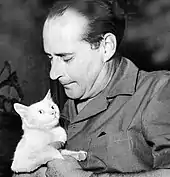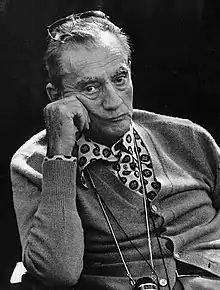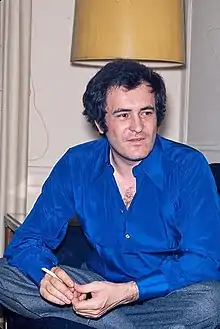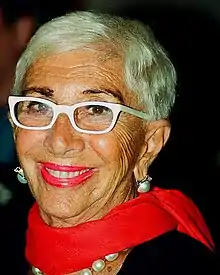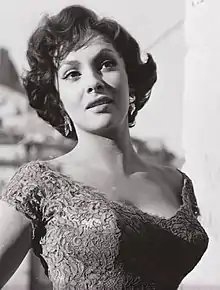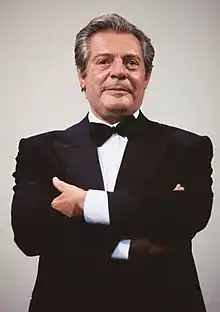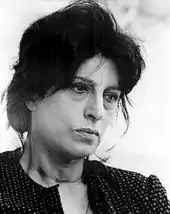Cinema of Italy
The cinema of Italy (Italian: Cinema italiano, pronounced ['ˈtʃiːnema itaˈljaːno]) comprises the films made within Italy or by Italian directors. Since its beginning, Italian cinema has influenced film movements worldwide. Italy is one of the birthplaces of art cinema and the stylistic aspect of film has been the most important factor in the history of Italian film.[5][6] As of 2018, Italian films have won 14 Academy Awards for Best Foreign Language Film (the most of any country) as well as 12 Palmes d'Or (the second-most of any country), one Academy Award for Best Picture and many Golden Lions and Golden Bears.
| Cinema of Italy | |
|---|---|
 A collage of notable Italian actors and filmmakers[lower-alpha 1] | |
| No. of screens | 3,217 (2013)[1] |
| • Per capita | 5.9 per 100,000 (2013)[1] |
| Main distributors | Medusa Film (16.7%) Warner Bros. (13.8%) 20th Century Studios (13.7%)[2] |
| Produced feature films (2018)[3] | |
| Total | 273 |
| Fictional | 180 |
| Documentary | 93 |
| Number of admissions (2018)[3] | |
| Total | 85,900,000 |
| • Per capita | 1.50 (2012)[4] |
| National films | 19,900,000 (23.17%) |
| Gross box office (2018)[3] | |
| Total | €555 million |
| National films | €128 million (23.03%) |
The history of Italian cinema began a few months after the Lumière brothers began motion picture exhibitions.[7][8] The first Italian director is considered to be Vittorio Calcina, a collaborator of the Lumière Brothers, who filmed Pope Leo XIII in 1896. The first films date back to 1896 and were made in the main cities of the Italian peninsula.[7][8] These brief experiments immediately met the curiosity of the popular class, encouraging operators to produce new films until they laid the foundations for the birth of a true film industry.[7][8] In the early years of the 20th century, silent cinema developed, bringing numerous Italian stars to the forefront until the end of World War I.[9] In the early 1900s, artistic and epic films such as Otello (1906), The Last Days of Pompeii (1908), L'Inferno (1911), Quo Vadis (1913), and Cabiria (1914), were made as adaptations of books or stage plays. Italian filmmakers were using complex set designs, lavish costumes, and record budgets, to produce pioneering films.
One of the first cinematic avant-garde movements, Italian futurism, took place in the late 1910s. After a period of decline in the 1920s, the Italian film industry was revitalized in the 1930s with the arrival of sound film. A popular Italian genre during this period, the Telefoni Bianchi, consisted of comedies with glamorous backgrounds.[10] While Italy's Fascist government provided financial support for the nation's film industry, notably the construction of the Cinecittà studios (the largest film studio in Europe), it also engaged in censorship, and thus many Italian films produced in the late 1930s were propaganda films. A new era took place at the end of World War II with the birth of the influential Italian neorealist movement, reaching a vast consensus of audiences and critics throughout the post-war period,[11] and which launched the directorial careers of Luchino Visconti, Roberto Rossellini, and Vittorio De Sica. Neorealism declined in the late 1950s in favor of lighter films, such as those of the Commedia all'italiana genre and important directors like Federico Fellini and Michelangelo Antonioni. Actresses such as Sophia Loren, Giulietta Masina and Gina Lollobrigida achieved international stardom during this period.[10]
From the mid-1950s to the end of the 1970s, Commedia all'italiana and many other genres arose due to auteur cinema, and Italian cinema reached a position of great prestige both nationally and abroad.[12][13] The Spaghetti Western achieved popularity in the mid-1960s, peaking with Sergio Leone's Dollars Trilogy, which featured enigmatic scores by composer Ennio Morricone, which have become popular culture icons of the Western genre. Erotic Italian thrillers, or giallos, produced by directors such as Mario Bava and Dario Argento in the 1970s, influenced the horror genre worldwide. Since the 1980s, due to multiple factors, Italian production has gone through a crisis that has not prevented the production of quality films in the 1990s and into the new millennium, thanks to a revival of Italian cinema, awarded and appreciated all over the world.[14][15][16] During the 1980s and 1990s, directors such as Ermanno Olmi, Bernardo Bertolucci, Giuseppe Tornatore, Gabriele Salvatores and Roberto Benigni brought critical acclaim back to Italian cinema,[10] while the most popular directors of the 2000s and 2010s were Matteo Garrone, Paolo Sorrentino, Marco Bellocchio, Nanni Moretti and Marco Tullio Giordana.[17]
The country is also famed for its prestigious Venice Film Festival, the oldest film festival in the world, held annually since 1932 and awarding the Golden Lion;[18] and for the David di Donatello. In 2008 the Venice Days ("Giornate degli Autori"), a section held in parallel to the Venice Film Festival, has produced in collaboration with Cinecittà studios and the Ministry of Cultural Heritage a list of 100 films that have changed the collective memory of the country between 1942 and 1978: the "100 Italian films to be saved".
History
1890s
The history of Italian cinema began a few months after the French Lumière brothers, who made the first public screening of a film on 28 December 1895, an event considered the birth of cinema, began motion picture exhibitions.[7][8] The first Italian director is considered to be Vittorio Calcina, a collaborator of the Lumière Brothers, who filmed Pope Leo XIII on 26 February 1896 in the short film Sua Santità papa Leone XIII ("His Holiness Pope Leo XIII").[19] He then became the official photographer of the House of Savoy,[20] the Italian ruling dynasty from 1861 to 1946. In this role he filmed the first Italian film, Sua Maestà il Re Umberto e Sua Maestà la Regina Margherita a passeggio per il parco a Monza ("His Majesty the King Umberto and His Majesty the Queen Margherita strolling through the Monza Park"), believed to have been lost until it was rediscovered by the Cineteca Nazionale in 1979.[21]
The Lumière brothers commenced public screenings in Italy in 1896 starting in March, in Rome and Milan; in April in Naples, Salerno and Bari; in June in Livorno; in August in Bergamo, Bologna and Ravenna; in October in Ancona;[22] and in December in Turin, Pescara and Reggio Calabria.[23] Not long before, in 1895, Filoteo Alberini patented his "kinetograph", a shooting and projecting device not unlike that of the Lumières brothers.[10][24]
Italian Lumière trainees produced short films documenting everyday life and comic strips in the late 1890s and early 1900s. Before long, other pioneers made their way. Italo Pacchioni, Arturo Ambrosio, Giovanni Vitrotti and Roberto Omegna were also active. The success of the short films were immediate. The cinema fascinated with its ability to show distant geographic realities with unprecedented precision and, vice versa, to immortalize everyday moments. Sporting events, local events, intense road traffic, the arrival of a train, visits by famous people, but also natural disasters and calamities are filmed.
Titles of the time include, Arrivo del treno alla Stazione di Milano ("Arrival of the train at Milan station") (1896), La battaglia di neve ("The snow battle") (1896), la gabbia dei matti ("The madmen's cage") (1896), Ballo in famiglia ("Family dance") (1896), Il finto storpio al Castello Sforzesco ("The fake cripple at the Castello Sforzesco") (1896) and La Fiera di Porta Genova ("The fair of Porta Genova") (1898), all shot by Italo Pacchioni, who was also the inventor of a camera and projector, inspired by the cinematograph of Lumière brothers, kept at the Cineteca Italiana in Milan.[25]
If the interest of the masses were enthusiastic, the technological novelty would likely be snubbed, at least at the beginning, by intellectuals and the press.[26] Despite initial doubt, in just two years, cinema climbs the hierarchy of society, intriguing the wealthier classes. On 28 January 1897, prince Victor Emmanuel and princess Elena of Montenegro attended a screening organized by Vittorio Calcina, in a room of the Pitti Palace in Florence.[27] Interested in experimenting with the new medium, they were filmed in S.A.R. il Principe di Napoli e la Principessa Elena visitano il battistero di S. Giovanni a Firenze ("Their real heights the Prince of Naples and Princess Elena visit the baptistery of Saint John in Florence") and on the day of their wedding in Dimostrazione popolare alle LL. AA. i Principi sposi (al Pantheon – Roma) ("Popular demonstration at the their heights the princes spouses (at the Pantheon – Rome)").[28][29]
1900s

In the early years of the 20th century, the phenomenon of itinerant cinemas developed throughout Italy, providing literacy of the visual medium.[30] This innovative form of spectacle ran out, in a short time, a number of optical attractions such as magic lanterns, cineographers, stereoscopes, panoramas and dioramas that had fueled the European imagination and favored the circulation of a common market for images.[31] The nascent Italian cinema, therefore, is still linked to the traditional shows of the commedia dell'arte or to those typical of circus folklore. Public screenings take place in the streets, in cafes or in variety theaters in the presence of a swindler who has the task of promoting and enriching the story.[32]
Between 1903 and 1909 the itinerant cinema Italian film was queifing, until then considered as a freak phenomenon, took on consistency assuming the characteristics of an authentic industry, led by three major organizations: Cines, based in Rome; and the Turin-based companies Ambrosio Film and Itala Film.[23] Other companies soon followed in Milan and Naples, and these early companies quickly attained a respectable production quality and were able to market their products both within Italy and abroad. Early Italian films typically consisted of adaptations of books or stage plays, such as Mario Caserini's Otello (1906) and Arturo Ambrosio's 1908 adaptation of the novel, The Last Days of Pompeii. Also popular during this period were films about historical figures, such as Caserini's Beatrice Cenci (1909) and Ugo Falena's Lucrezia Borgia (1910).
The discovery of the spectacular potential of the cinematographic medium favored the development of a cinema with great ambitions, capable of incorporating all the cultural and historical suggestions of the country.[23] Education is an inexhaustible source of ideas, ideas that can be easily assimilated not only by a cultured public but also by the masses.[23] Dozens of characters met in the textbooks make their entrance on the big screen such as the Count of Monte Cristo, Giordano Bruno, Judith beheading Holofernes, Francesca da Rimini, Lorenzino de' Medici, Rigoletto, Count Ugolino and others.[23] From an iconographic point of view, the main references are the great Renaissance and neoclassical artists, as well as symbolists and popular illustrations.[33]
1910s
In the 1910s, the Italian film industry developed rapidly.[34] In 1912, the year of the greatest expansion, 569 films were produced in Turin, 420 in Rome and 120 in Milan.[35] L'Inferno, produced by Milano Films in 1911, was the first Italian feature film ever made.[36] Popular early Italian actors included Emilio Ghione, Alberto Collo, Bartolomeo Pagano, Amleto Novelli, Lyda Borelli, Ida Carloni Talli, Lidia Quaranta and Maria Jacobini.[10]
Enrico Guazzone's 1913 film Quo Vadis was one of the first blockbusters in the history of cinema, using thousands of extras and a lavish set design.[37] Giovanni Pastrone's 1914 film Cabiria was an even larger production, requiring two years and a record budget to produce, it was the first epic film ever made and it is considered the most famous Italian silent film.[34][38] It was also the first film in history to be shown in the White House.[39][40][41] Nino Martoglio's Lost in Darkness, also produced in 1914, documented life in the slums of Naples, and is considered a precursor to the Neorealist movement of the 1940s and 1950s.[10]
Between 1913 and 1920 there was the rise, development and decline of the phenomenon of cinematographic stardom, born with the release of Ma l'amor mio non-muore (1913), by Mario Caserini. The film had great success with the public and encoded the setting and aesthetics of female stardom. Within just a few years, Eleonora Duse, Pina Menichelli, Rina De Liguoro, Leda Gys, Hesperia, Vittoria Lepanto, Mary Cleo Tarlarini and Italia Almirante Manzini established themselves. Films such as Fior di male (1914), by Carmine Gallone, Il fuoco (1915), by Giovanni Pastrone, Rapsodia satanica (1917), by Nino Oxilia and Cenere (1917), by Febo Mari, changed the national costume, imposing canons of beauty, role models and objects of desire.[42] These models, strongly stylized according to the cultural and artistic trends of the time, moved away from naturalism in favor of melodramatic acting, pictorial gesture and theatrical pose; all favored by the incessant use of close-up which focuses the attention on the expressiveness of the actress.[43]
Cinema futurista (1910s)

Between 1911 and 1919, Italy was home to the first avant-garde movement in cinema, inspired by the country's Futurism, an artistic and social movement. Futurism emphasized dynamism, speed, technology, youth, violence, and objects such as the car, the airplane, and the industrial city. Its key figures were the Italians Filippo Tommaso Marinetti, Umberto Boccioni, Carlo Carrà, Fortunato Depero, Gino Severini, Giacomo Balla, and Luigi Russolo. It glorified modernity and aimed to liberate Italy from the weight of its past.[44]
The 1916 Manifesto of Futuristic Cinematography was signed by Filippo Tommaso Marinetti, Armando Ginna, Bruno Corra, Giacomo Balla and others. To the Futurists, cinema was an ideal art form, being a fresh medium, and able to be manipulated by speed, special effects and editing. Most of the futuristic-themed films of this period have been lost, but critics cite Thaïs (1917) by Anton Giulio Bragaglia as one of the most influential, serving as the main inspiration for German Expressionist cinema in the following decade.
The Italian film industry struggled against rising foreign competition in the years following World War I.[10] Several major studios, among them Cines and Ambrosio, formed the Unione Cinematografica Italiana to coordinate a national strategy for film production. This effort was largely unsuccessful, however, due to a wide disconnect between production and exhibition (some movies weren't released until several years after they were produced).[45]
1920s

With the end of World War I, Italian cinema went through a period of crisis due to many factors: production disorganization, increased costs, technological backwardness, loss of foreign markets and inability to cope with international competition, in particular with that of Hollywood.[46] The main causes include the lack of a generational change with a production still dominated by filmmakers and producers of literary training, unable to face the challenges of modernity. The first half of the 1920s marked a sharp decrease in production; from 350 films produced in 1921 to 60 in 1924.[47]
The revival of Italian cinema took place at the end of the decade with the production of larger-scale films. Among the notable Italian films of the late silent era were Mario Camerini's Rotaie (1929) and Alessandro Blasetti's Sun (1929).[10] While not comparable to the best results of international cinema of the period, the works of Camerini and Blasetti testify to a generational transition between Italian directors and intellectuals, and above all an emancipation from literary models and an approach to the tastes of the public.
1930s
In 1930, Gennaro Righelli directed the first Italian talking picture, The Song of Love. This was followed by Blasetti's Mother Earth (1930) and Resurrection (1931), and Camerini's Figaro and His Great Day (1931). The advent of talkies led to stricter censorship by the Fascist government.[10] Historical films such as Blasetti's 1860 (1934) and Carmine Gallone's Scipio Africanus: The Defeat of Hannibal (1937) were also popular during this period.[10]
Italian-born director Frank Capra received three Academy Awards for Best Director for the films It Happened One Night (the first Big Five winner at the Academy Awards), Mr. Deeds Goes to Town and You Can't Take It with You.
Telefoni bianchi (1930s–1940s)
During the 1930s, light comedies known as telefoni bianchi ("white telephones") were predominant in Italian cinema.[10] These films, which featured lavish set designs, promoted conservative values and respect for authority, and thus typically avoided the scrutiny of government censors. Important examples of telefoni bianchi include Guido Brignone's Paradiso (1932), Carlo Bragaglia's O la borsa o la vita (1933), and Righelli's Together in the Dark (1935).
Cinecittà (1930s–present)
In 1934, the Italian government created the General Directorate for Cinema (Direzione Generale per le Cinematografia), and appointed Luigi Freddi its director. With the approval of Benito Mussolini, this directorate called for the establishment of a town southeast of Rome devoted exclusively to cinema, dubbed the Cinecittà ("Cinema City").
Completed in 1937, the Cinecittà provided everything necessary for filmmaking: theaters, technical services, and even a cinematography school, the Centro Sperimentale di Cinematografia, for younger apprentices. The Cinecittà studios were Europe's most advanced production facilities, and greatly boosted the technical quality of Italian films.[10] Many films are still shot entirely in Cinecittà. Benito Mussolini founded Cinecittà studio also for the production of Fascist propaganda until World War II.[49]
During this period, Mussolini's son, Vittorio, created a national production company and organized the work of noted authors, directors and actors (including even some political opponents), thereby creating an interesting communication network among them, which produced several noted friendships and stimulated cultural interaction.
Neorealism (1940s–1950s)

By the end of World War II, the Italian "neorealist" movement had begun to take shape. Neorealist films typically dealt with the working class (in contrast to the Telefoni Bianchi), and were shot on location. Many neorealist films, but not all, used non-professional actors. Though the term "neorealism" was used for the first time to describe Luchino Visconti’s 1943 film, Ossessione, there were several important precursors to the movement, most notably Camerini's What Scoundrels Men Are! (1932), which was the first Italian film shot entirely on location, and Blasetti's 1942 film, Four Steps in the Clouds.[51]

Ossessione angered Fascist officials. Upon viewing the film, Vittorio Mussolini is reported to have shouted, "This is not Italy!" before walking out of the theater.[52] The film was subsequently banned in the Fascist-controlled parts of Italy. While neorealism exploded after the war, and was incredibly influential at the international level, neorealist films made up only a small percentage of Italian films produced during this period, as postwar Italian moviegoers preferred escapist comedies starring actors such as Totò and Alberto Sordi.[51]
Neorealist works such as Roberto Rossellini's trilogy Rome, Open City (1945), Paisà (1946), and Germany, Year Zero (1948), with professional actors such as Anna Magnani and a number of non-professional actors, attempted to describe the difficult economic and moral conditions of postwar Italy and the changes in public mentality in everyday life. Visconti's The Earth Trembles (1948) was shot on location in a Sicilian fishing village, and used local non-professional actors. Giuseppe De Santis, on other hand, used actors such as Silvana Mangano and Vittorio Gassman in his 1949 film, Bitter Rice, which is set in the Po Valley during rice-harvesting season.
Poetry and cruelty of life were harmonically combined in the works that Vittorio De Sica wrote and directed together with screenwriter Cesare Zavattini: among them, Shoeshine (1946), The Bicycle Thief (1948) and Miracle in Milan (1951). The 1952 film Umberto D. showed a poor old man with his little dog, who must beg for alms against his dignity in the loneliness of the new society. This work is perhaps De Sica's masterpiece and one of the most important works in Italian cinema.[53] It was not a commercial success[53] and since then it has been shown on Italian television only a few times. Yet it is perhaps the most violent attack, in the apparent quietness of the action, against the rules of the new economy, the new mentality, the new values, and it embodies both a conservative and a progressive view.[53]
Although Umberto D. is considered the end of the neorealist period, later films such as Federico Fellini's La Strada (1954) and De Sica's 1960 film Two Women (for which Sophia Loren won the Oscar for Best Actress) are grouped with the genre. Director Pier Paolo Pasolini's first film, Accattone (1961), shows a strong neorealist influence.[51] Italian neorealist cinema influenced filmmakers around the world, and helped inspire other film movements, such as the French New Wave and the Polish Film School. The Neorealist period is often simply referred to as "The Golden Age" of Italian Cinema by critics, filmmakers, and scholars.
 Ossessione (1943), by Luchino Visconti.
Ossessione (1943), by Luchino Visconti. A still shot from Rome, Open City (1945), by Roberto Rossellini.
A still shot from Rome, Open City (1945), by Roberto Rossellini. Bicycle Thieves (1948), by Vittorio De Sica, ranked among the best movies ever made and part of the canon of classic cinema.[54]
Bicycle Thieves (1948), by Vittorio De Sica, ranked among the best movies ever made and part of the canon of classic cinema.[54] Gillo Pontecorvo's The Battle of Algiers (1966) is often associated with Italian neorealism.[55]
Gillo Pontecorvo's The Battle of Algiers (1966) is often associated with Italian neorealism.[55]
Calligrafismo (1940s)
Calligrafismo is in a sharp contrast to telefoni bianchi-American style comedies and is rather artistic, highly formalistic, expressive in complexity and deals mainly with contemporary literary material,[56] above all the pieces of Italian realism from authors like Corrado Alvaro, Ennio Flaiano, Emilio Cecchi, Francesco Pasinetti, Vitaliano Brancati, Mario Bonfantini and Umberto Barbaro.[57]
1950s
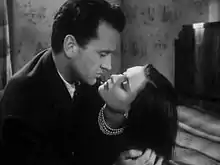
Starting from the mid-1950s, Italian cinema freed itself from neorealism by tackling purely existential topics, films with different styles and points of view, often more introspective than descriptive.[58] Thus we are witnessing a new flowering of filmmakers who contribute in a fundamental way to the development of the art.[58]
Michelangelo Antonioni is the first to establish himself, becoming a reference author for all contemporary cinema.[59] This charge of novelty is recognizable from the beginning as the director's first work, Story of a Love Affair (1950), marks an indelible break with the world of neorealism and the consequent birth of a modern cinema.[59] Antonioni investigated the world of the Italian bourgeoisie with a critical eye, left out of the post-war cinematic lens. In doing so, works of psychological research such as I Vinti (1952), The Lady Without Camelias (1953) and Le Amiche (1955), free adaptation of the short story Tra donne sole by Cesare Pavese, came to light. In 1957, he staged the unusual proletarian drama Il Grido, with which he obtained critical acclaim.
In 1955, the David di Donatello was established, with its Best Picture category being awarded for the first time only in 1970.
Federico Fellini (1950s–1990s)

Federico Fellini is recognized as one of the greatest and most influential filmmakers of all time. Fellini won the Palme d'Or for La Dolce Vita, was nominated for twelve Academy Awards, and won four in the category of Best Foreign Language Film, the most for any director in the history of the academy. He received an honorary award for Lifetime Achievement at the 65th Academy Awards in Los Angeles. His other well-known films include La Strada (1954), Nights of Cabiria (1957), Juliet of the Spirits (1967), Satyricon (1969), Roma (1972), Amarcord (1973), and Fellini's Casanova (1976).
Personal and highly idiosyncratic visions of society, Fellini's films are a unique combination of memory, dreams, fantasy and desire. The adjectives "Fellinian" and "Felliniesque" are "synonymous with any kind of extravagant, fanciful, even baroque image in the cinema and in art in general".[61] La Dolce Vita contributed the term paparazzi to the English language, derived from Paparazzo, the photographer friend of journalist Marcello Rubini (Marcello Mastroianni).[62]
Contemporary filmmakers such as Tim Burton,[63] Terry Gilliam,[64] Emir Kusturica,[65] and David Lynch[66] have cited Fellini's influence on their work.
Pink neorealism (1950s–1960s)
It has been said that after Umberto D. nothing more could be added to neorealism. Possibly because of this, neorealism effectively ended with that film; subsequent works turned toward lighter atmospheres, perhaps more coherent with the improving conditions of the country, and this genre has been called pink neorealism. This trend allowed better-"equipped" actresses to become real celebrities, such as Sophia Loren, Gina Lollobrigida, Silvana Pampanini, Lucia Bosé, Barbara Bouchet, Eleonora Rossi Drago, Silvana Mangano, Virna Lisi, Claudia Cardinale and Stefania Sandrelli. Soon pink neorealism, such as Pane, amore e fantasia (1953) with Vittorio De Sica and Gina Lollobrigida, was replaced by the Commedia all'italiana, a unique genre that, born on an ideally humouristic line, talked instead very seriously about important social themes.
Commedia all'Italiana (1950s–1980s)

Italian Comedy is generally considered to have started with Mario Monicelli's I soliti Ignoti (Big Deal on Madonna Street, 1958) and derives its name from the title of Pietro Germi's Divorzio all'Italiana (Divorce Italian Style, 1961). For a long time this definition was used with a derogatory intention.
Vittorio Gassman, Marcello Mastroianni, Ugo Tognazzi, Alberto Sordi, Claudia Cardinale, Monica Vitti and Nino Manfredi were among the stars of these movies, that described the years of the economical reprise and investigated Italian customs, a sort of self-ethnological research.
In 1961 Dino Risi directed Una vita difficile (A Difficult Life), then Il sorpasso (The Easy Life), now a cult-movie, followed by: I Mostri (The Monsters, also known as 15 From Rome), In nome del Popolo Italiano (In the Name of the Italian People) and Profumo di donna (Scent of a Woman). Monicelli's works include La grande guerra (The Great War), I compagni (Comrades, also known as The Organizer), L'Armata Brancaleone, Vogliamo i colonnelli (We Want the Colonels), Romanzo popolare (Popular Novel) and the Amici miei series.
Totò (1930s–1960s)
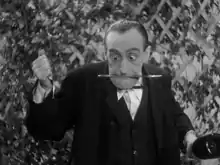
At this time, on the more commercial side of production, the phenomenon of Totò, a Neapolitan actor who is acclaimed as the major Italian comic, exploded. His films (often with Aldo Fabrizi, Peppino De Filippo and almost always with Mario Castellani) expressed a sort of neorealistic satire, in the means of a guitto (a "hammy" actor) as well as with the art of the great dramatic actor he also was.
A "film-machine" who produced dozens of titles per year, his repertoire was frequently repeated. His personal story (a prince born in the poorest rione (section of the city) of Naples), his unique twisted face, his special mimic expressions and his gestures created an inimitable personage and made him one of the most beloved Italians of the 1960s.
Some of his best-known films are Fifa e Arena, Totò al Giro d'Italia, Totò Sceicco, Guardie e ladri, Totò e le donne, Totò Tarzan, Totò terzo uomo, Totò a colori (one of the first Italian color movies, 1952, in Ferraniacolor), I soliti ignoti, Totò, Peppino e la malafemmina, La legge è legge. Pier Paolo Pasolini's The Hawks and the Sparrows and the episode "Che cosa sono le nuvole" from Capriccio all'italiana (the latter released after his death), showed his dramatic skills.
Don Camillo and Peppone (1950s–1980s)
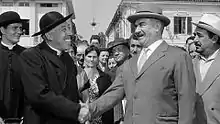
A series of black-and-white films based on Don Camillo and Peppone characters created by the Italian writer and journalist Giovannino Guareschi were made between 1952 and 1965. These were French-Italian coproductions, and starred Fernandel as the Italian priest Don Camillo and Gino Cervi as Giuseppe 'Peppone' Bottazzi, the Communist Mayor of their rural town. The titles are: The Little World of Don Camillo (1952), The Return of Don Camillo (1953), Don Camillo's Last Round (1955), Don Camillo: Monsignor (1961), and Don Camillo in Moscow (1965).
The movies were a huge commercial success in their native countries. In 1952, Little World of Don Camillo became the highest-grossing film in both Italy and France,[67] while The Return of Don Camillo was the second most popular film of 1953 at the Italian and French box office.[68]
Mario Camerini began filming the film Don Camillo e i giovani d'oggi, but had to stop filming due to Fernandel's falling ill, which resulted in his untimely death. The film was then realized in 1972 with Gastone Moschin playing the role of Don Camillo and Lionel Stander as Peppone.
A new Don Camillo film, titled The World of Don Camillo, was also remade in 1983, an Italian production with Terence Hill directing and also starring as Don Camillo. Colin Blakely performed Peppone in one of his last film roles.
Hollywood on the Tiber (1950s–1960s)
.jpg.webp)
In the late 1940s, Hollywood studios began to shift production abroad to Europe. Italy was, along with Britain, one of the major destinations for American film companies. Shooting at Cinecittà, large-budget films such as Quo Vadis (1951), Roman Holiday (1953), Ben-Hur (1959), and Cleopatra (1963) were made in English with international casts and sometimes, but not always, Italian settings or themes.
The heyday of what was dubbed '"Hollywood on the Tiber" was between 1950 and 1970, during which time many of the most famous names in world cinema made films in Italy. The phrase "Hollywood on Tiber", a reference to the river that runs through Rome, was coined in 1950 by Time magazine during the making of Quo Vadis.[69]
Peplum (a.k.a. Sword and Sandal) (1950s–1960s)
With the release of 1958's Hercules, starring American bodybuilder Steve Reeves, the Italian film industry gained entree to the American film market. These films, many with mythological or Bible themes, were low-budget costume/adventure dramas, and had immediate appeal with both European and American audiences. Besides the many films starring a variety of muscle men as Hercules, heroes such as Samson and Italian fictional hero Maciste were common. Sometimes dismissed as low-quality escapist fare, the Peplums allowed newer directors such as Sergio Leone and Mario Bava a means of breaking into the film industry. Some, such as Mario Bava's Hercules in the Haunted World (Italian: Ercole Al Centro Della Terra) are considered seminal works in their own right. As the genre matured, budgets sometimes increased, as evidenced in 1962's I sette gladiatori (The Seven Gladiators in 1964 US release), a wide-screen epic with impressive sets and matte-painting work. Most Peplum films were in color, whereas previous Italian efforts had often been black and white.
 Kirk Douglas and Silvana Mangano in a pause during the shootings of Ulysses (1954)
Kirk Douglas and Silvana Mangano in a pause during the shootings of Ulysses (1954) Duel of the Titans (1961)
Duel of the Titans (1961).JPG.webp) My Son, the Hero (1962)
My Son, the Hero (1962)
Musicarelli (1950s–1970s)
Musicarello (pl. musicarelli) is a film subgenre which emerged in Italy and which is characterised by the presence in main roles of young singers, already famous among their peers, supported by comic actors. The genre began in the late 1950s, and had its peak of production in the 1960s.[70] The film which started the genre is considered to be I ragazzi del Juke-Box by Lucio Fulci.[71] At the heart of the musicarello is a hit song, or a song that the producers hoped would become a hit, that usually shares its title with the film itself and sometimes has lyrics depicting a part of the plot.[72]
The Spaghetti Western (1960s–1970s)

On the heels of the Peplum craze, a related genre, the Spaghetti Western arose and was popular both in Italy and elsewhere. These films differed from traditional westerns by being filmed in Europe on limited budgets, but featured vivid cinematography.
The most popular Spaghetti Westerns were those of Sergio Leone, whose Dollars Trilogy (1964's A Fistful of Dollars, an unauthorized remake of the Japanese film Yojimbo by Akira Kurosawa; 1965's For a Few Dollars More, an original sequel; and 1966's The Good, the Bad and the Ugly, a World-famous prequel), featuring Clint Eastwood as a character marketed as "the Man with No Name" and notorious scores by Ennio Morricone, came to define the genre along with Once Upon a Time in the West (1968).
Another popular Spaghetti Western film is Sergio Corbucci Django (1966), starring Franco Nero as the titular character, another Yojimbo plagiarism, produced to capitalize on the success of A Fistful of Dollars. The original Django was followed by both an authorized sequel (1987's Django Strikes Again) and an overwhelming number of unauthorized uses of the same character in other films.
 Clint Eastwood as the Man with No Name in For a Few Dollars More, part of Sergio Leone's Dollars Trilogy.
Clint Eastwood as the Man with No Name in For a Few Dollars More, part of Sergio Leone's Dollars Trilogy..jpg.webp) Franco Nero as Django in the film of the same name.
Franco Nero as Django in the film of the same name.
Bud Spencer and Terence Hill (1960s–1990s)
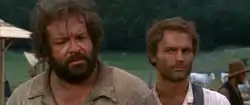
Also considered Spaghetti Westerns is a film genre which combined traditional western ambiance with a Commedia all'italiana-type comedy; films including They Call Me Trinity and Trinity Is STILL My Name!, which featured Bud Spencer and Terence Hill, the stage names of Carlo Pedersoli and Mario Girotti.
Terence Hill and Bud Spencer made numerous films together.[73] Most of their early films were Spaghetti Westerns, beginning with God Forgives... I Don't! (1967), the first part of a trilogy, followed by Ace High (1968) and Boot Hill (1969), but they also starred in comedies such as ... All the Way, Boys! (1972) and Watch Out, We're Mad! (1974).
The next films shot by the couple of actors, almost all comedies, were Two Missionaries (1974), Crime Busters (1977), Odds and Evens (1978), I'm for the Hippopotamus (1979), Who Finds a Friend Finds a Treasure (1981), Go for It (1983), Double Trouble (1984), Miami Supercops (1985) and Troublemakers (1994).
Giallo (Thriller/Horror) (1960s–1970s)
During the 1960s and 70s, Italian filmmakers Mario Bava, Riccardo Freda, Antonio Margheriti and Dario Argento developed giallo horror films that become classics and influenced the genre in other countries. Representative films include: Black Sunday, Castle of Blood, Twitch of the Death Nerve, The Bird with the Crystal Plumage, Deep Red and Suspiria.
Cannibal films are a subgenre of horror films made predominantly by Italian filmmakers during the 1970s and 1980s. This subgenre is a collection of graphically violent movies that usually depict cannibalism by primitive, Stone Age natives deep within the Asian or South American rainforests.[74]
Due to the success of the James Bond film series the Italian film industry made large amounts of imitations and spoofs in the Eurospy genre from 1964 to 1967.
Following the 1960s boom of shockumentary "Mondo films" such as Gualtiero Jacopetti's Mondo Cane, during the late 1970s and early 1980s, Italian cinema became internationally synonymous with violent horror films. These films were primarily produced for the video market and were credited with fueling the "video nasty" era in the United Kingdom.
Directors in this genre included Lucio Fulci, Joe D'Amato, Umberto Lenzi and Ruggero Deodato. Some of their films faced legal challenges in the United Kingdom; after the Video Recordings Act of 1984, it became a legal offense to sell a copy of such films as Cannibal Holocaust and SS Experiment Camp. Italian films of this period are usually grouped together as exploitation films.
Several countries charged Italian studios with exceeding the boundaries of acceptability with their late-1970s Nazi exploitation films, inspired by American movies such as Ilsa, She Wolf of the SS. The Italian works included the notorious but comparatively tame SS Experiment Camp and the far more graphic Last Orgy of the Third Reich (Italian: L'ultima orgia del III Reich). These films showed, in great detail, sexual crimes against prisoners at concentration camps. These films may still be banned in the United Kingdom and other countries.
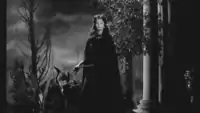 Barbara Steele in Black Sunday (1960)
Barbara Steele in Black Sunday (1960) A scene from Blood and Black Lace (1964)
A scene from Blood and Black Lace (1964) Giuliana Calandra in a famous scene from Deep Red (1975)
Giuliana Calandra in a famous scene from Deep Red (1975) Suzy (Jessica Harper) and Sara (Stefania Casini) in Suspiria, the first film in Dario Argento's "The Three Mothers" trilogy
Suzy (Jessica Harper) and Sara (Stefania Casini) in Suspiria, the first film in Dario Argento's "The Three Mothers" trilogy
Poliziotteschi (1960s–1970s)
.PNG.webp)
Poliziotteschi (Italian pronunciation: [polittsjotˈteski]; plural of poliziottesco) films constitute a subgenre of crime and action film that emerged in Italy in the late 1960s and reached the height of their popularity in the 1970s. They are also known as polizieschi all'italiana, Euro-crime, Italo-crime, spaghetti crime films', or simply Italian crime films.
Influenced by both 1970s French crime films and gritty 1960s and 1970s American cop films and vigilante films,[75] poliziotteschi films were made amidst an atmosphere of socio-political turmoil in Italy and increasing Italian crime rates.
The films generally featured graphic and brutal violence, organized crime, car chases, vigilantism, heists, gunfights, and corruption up to the highest levels. The protagonists were generally tough working class loners, willing to act outside a corrupt or overly bureaucratic system.[76] Most notable international actors acted in this genre of films such Alain Delon, Henry Silva, Fred Williamson, Charles Bronson, Tomas Milian and others international stars.
Franco and Ciccio (1960s–1980s)
Franco and Ciccio were a comedy duo formed by Italian actors Franco Franchi (1928–1992) and Ciccio Ingrassia (1922–2003), particularly popular in the 1960s and 1970s. Together, they appeared in 116 films, usually as the main characters, and occasionally as supporting characters in movies featuring well-known actors like Totò, Domenico Modugno, Vittorio Gassman, Buster Keaton and Vincent Price.
Their collaboration began in 1954, and ended with Franchi's death in 1992. The two made their debuts in 1960 with the film Appuntamento a Ischia. After, seeing them in this film Modugno who, wanted them with him in his film,[77][78] and remained active until 1984 when they shot their last film together, Kaos, although there were some interruptions in 1973 and from 1975 to 1980.[79]
1970s
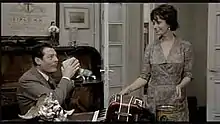
In the 1970s the work done by the director Lina Wertmüller was influential, who together with the well-established actors Giancarlo Giannini and Mariangela Melato, gave life to successful films such as The Seduction of Mimi (1972), Love and Anarchy (1973) and Swept Away (1974). Two years later, with Seven Beauties (1976), she obtained four nominations for the Academy Awards, making her the first woman ever to receive a nomination for best director.[80]
The last protagonist of the great season of the comedy is the director Ettore Scola. Throughout the 1950s, he played the role of screenwriter, and then makes his directorial debut in 1964 with the film Let's Talk About Women. In 1974, he directed his best known film, We All Loved Each Other So Much, which traces 30 years of Italian history through the stories of three friends: the lawyer Gianni Perego (Vittorio Gassman), the porter Antonio (Nino Manfredi) and the intellectual Nicola (Stefano Satta Flores). Other films include, Down and Dirty (1976) starring Nino Manfredi, and A Special Day (1977) starring Sophia Loren and Marcello Mastroianni.[81]
The auteur cinema of the 1960s continues its path by analyzing distinct themes and problems. A new authorial vision is emancipated from the surreal and existential veins of Fellini and Antonioni which sees cinema as an ideal means of denouncing corruption and malfeasance,[82] both in the political system and in the industrial world. Thus was born the structure of the investigative film which, starting from the neorealist analysis of the facts, adding to them a concise critical judgment, with the manifest intent of shaking the consciences of public opinion. This typology deliberately touches upon burning issues, often targeting the established power, with the intent of reconstructing a historical truth that is often hidden or denied.[83]
.jpg.webp)
One of Francesco Rosi's most famous films of denunciation is The Mattei Affair (1972), a rigorous documentary into the mysterious disappearance of Enrico Mattei, manager of Eni, a large Italian state group. The film won the Palme d'Or at the Cannes Film Festival and became (together with the tight Illustrious Corpses (1976)) a true model for similar denunciation films produced both in Italy and abroad. Famous films of denunciation by Elio Petri are The Working Class Goes to Heaven (1971), a corrosive denunciation of life in the factory (winner of the Palme d'Or at Cannes) and Investigation of a Citizen Above Suspicion (1970). The latter (accompanied by the incisive soundtrack by Ennio Morricone) is a dry psychoanalytic thriller centered on the aberrations of power, analyzed in a pathological key.[84] The film obtained a wide consensus, winning the Academy Award for Best International Feature Film the following year.
Arguments related to civilian cinema can be found in the work of Damiano Damiani, who with The Day of the Owl (1968) enjoyed considerable success. Other feature films include, Confessions of a Police Captain (1971), The Case Is Closed, Forget It (1971), How to Kill a Judge (1974) and I Am Afraid (1977). Also Pasquale Squitieri for the film Il prefetto di ferro (1977) and Giuliano Montaldo, who after some experiences as an actor, staged some historical and political films such as The Fifth Day of Peace (1970), Sacco & Vanzetti (1971) and Giordano Bruno (1973). Also Nanni Loy for the film In Prison Awaiting Trial (1971) starring Alberto Sordi.
Commedia sexy all'italiana (1970s–1980s)
During this time, commedia sexy all'italiana films, described by the film critics of the time as not artistic or "trash films", were very popular in Italy. Today they are widely re-evaluated and have become real cult movies. They also allowed the producers of Italian cinema to have enough revenue to produce successful artistic films. These comedy films were of little artistic value and reached their popularity by confronting Italian social taboos, most notably in the sexual sphere. Actors such as Lando Buzzanca, Lino Banfi, Renzo Montagnani, Alvaro Vitali, Gloria Guida, Barbara Bouchet and Edwige Fenech owe much of their popularity to these films.
Fantozzi (1970s–1990s)

Also considered part of the trash genre are films which feature Ugo Fantozzi, a character invented by Paolo Villaggio for his TV sketches and newspaper short stories. Although Villaggio's movies tend to bridge trash comedy with a more elevated social satire; this character had a great impact on Italian society, to such a degree that the adjective fantozziano entered the lexicon.
Of the many films telling of Fantozzi's misadventures, the most notable and famous were Fantozzi and Il secondo tragico Fantozzi, but many other were produced. The other films were Fantozzi contro tutti, directed by Neri Parenti (1980), Fantozzi subisce ancora, directed by Neri Parenti (1983), Superfantozzi, directed by Neri Parenti (1986), Fantozzi va in pensione, directed by Neri Parenti (1988), Fantozzi alla riscossa, directed by Neri Parenti (1990), Fantozzi in paradiso, directed by Neri Parenti (1993), Fantozzi - Il ritorno, directed by Neri Parenti (1996) and Fantozzi 2000 - La clonazione, directed by Domenico Saverni (1999).
Sceneggiata (1970s–1990s)

The sceneggiata (pl. sceneggiate) or sceneggiata napoletana is a form of musical drama typical of Naples. Beginning as a form of musical theatre after World War I, it was also adapted for cinema; sceneggiata films became especially popular in the 1970s, and contributed to the genre becoming more widely known outside Naples.[85] The most famous actors who played dramas were Mario Merola, Mario Trevi, and Nino D'Angelo.[86]
1980s
The 1980s was a period of decline for Italian filmmaking. In 1985, only 80 films were produced (the least since the postwar period)[88] and the total number of audience decreased from 525 million in 1970, to 123 million.[89] It is a physiological process that invests, in the same period as other countries, with a great cinematographic tradition such as Japan, United Kingdom and France. The era of producers ended; Carlo Ponti and Dino De Laurentiis work abroad, Goffredo Lombardo and Franco Cristaldi were no longer key figures. The crisis affects the Italian genre cinema above all, which, by virtue of the success of commercial television, is deprived of the vast majority of its audience.[90] As a result, movie theaters began showing mainly Hollywood films, which steadily took over, while many other movie theaters closed.
Among the major artistic films of this era were La città delle donne, E la nave va, Ginger and Fred by Fellini, L'albero degli zoccoli by Ermanno Olmi (winner of the Palme d'Or at the Cannes Film Festival), La notte di San Lorenzo by Paolo and Vittorio Taviani, Antonioni's Identificazione di una donna, and Bianca and La messa è finita by Nanni Moretti. Although not entirely Italian, Bernardo Bertolucci's The Last Emperor, winner of 9 Oscars including Best Picture and Best Director, and Once Upon a Time in America of Sergio Leone came out of this period also.
Non ci resta che piangere, directed by and starring both Roberto Benigni and Massimo Troisi, is a cult movie in Italy.
Carlo Verdone, actor, screenwriter and film director, is best known for his comedic roles in Italian classics, which he also wrote and directed. His career was jumpstarted by his first three successes, Un sacco bello (1980), Bianco, rosso e Verdone (1981) and Borotalco (1982). Since the 1990s, he has been introducing more serious subjects in his work, linked to the excesses of society and the individual's hardships in confronting it; some examples are Maledetto il giorno che t'ho incontrata (1992), Il mio miglior nemico (2006) and Io, loro e Lara (2010).
Francesco Nuti began his professional career as an actor in the late 1970s, when he formed the cabaret group Giancattivi together with Alessandro Benvenuti and Athina Cenci. The group took part in the TV shows Black Out and Non Stop for RAI TV, and shot their first feature film, West of Paperino (1981), written and directed by Benvenuti. The following year Nuti abandoned the trio and began a solo career with three movies directed by Maurizio Ponzi: What a Ghostly Silence There Is Tonight (1982), The Pool Hustlers (1982) and Son contento (1983). Starting in 1985, he began to direct his movies, scoring an immediate success with the films Casablanca, Casablanca and All the Fault of Paradise (1985), Stregati (1987), Caruso Pascoski, Son of a Pole (1988), Willy Signori e vengo da lontano (1990) and Women in Skirts (1991). The 1990s were however a period of decline for the Tuscan director, with poorly successful movies such as OcchioPinocchio (1994), Mr. Fifteen Balls (1998), Io amo Andrea (2000) and Caruso, Zero for Conduct (2001).
The cinepanettoni (singular: cinepanettone) are a series of farcical comedy films, one or two of which are scheduled for release annually in Italy during the Christmas period. The films were originally produced by Aurelio De Laurentiis' Filmauro studio.[91] These films are usually focused on the holidays of stereotypical Italians: bungling, wealthy and presumptuous members of the middle class who visit famous, glamorous or exotic places.
1990s

The economic crisis that emerged in the 1980s began to ease over the next decade.[92] Nonetheless, the 1992–93 and 1993–94 seasons marked an all-time low in the number of films made, in the national market share (15 percent), in the total number of viewers (under 90 million per year) and in the number of cinemas.[93] The effect of this industrial contraction sanctions the total disappearance of Italian genre cinema in the middle of the decade, as it was no longer suitable to compete with the contemporary big Hollywood blockbusters (mainly due to the enormous budget differences available), with its directors and actors who therefore almost entirely switch to television film.
A new generation of directors has helped return Italian cinema to a healthy level since the end of the 1980s. Probably the most noted film of the period is Nuovo Cinema Paradiso, for which Giuseppe Tornatore won a 1989 Oscar (awarded in 1990) for Best Foreign Language Film. This award was followed when Gabriele Salvatores's Mediterraneo won the same prize for 1991.
Il Postino: The Postman (1994), directed by the British Michael Radford and starring Massimo Troisi, received five nominations at the Academy Awards, including Best Picture and Best Actor for Troisi, and won for Best Original Score. Another exploit was in 1998 when Roberto Benigni won three Oscars for his movie Life Is Beautiful (La vita è bella) (Best Actor for Benigni himself, Best Foreign Film, Best Music). The film was also nominated for Best Picture.
Leonardo Pieraccioni made his directorial debut with The Graduates (1995).[94] In 1996 he directed his breakthrough film The Cyclone, which grossed Lire 75 billion at the box office.[95][96]
2000s
With the new millennium, the Italian film industry regained stability and critical recognition. In 1995, 93 films were produced,[97] while in 2005, 274 films were made.[98] In 2006, the national market share reached 31 percent.[99] In 2001, Nanni Moretti's film The Son's Room (La stanza del figlio) received the Palme d'Or at the Cannes Film Festival. Other noteworthy recent Italian films include: Jona che visse nella balena directed by Roberto Faenza, Il grande cocomero by Francesca Archibugi, The Profession of Arms (Il mestiere delle armi) by Olmi, L'ora di religione by Marco Bellocchio, Il ladro di bambini, Lamerica, The Keys to the House (Le chiavi di casa) by Gianni Amelio, I'm Not Scared (Io non-ho paura) by Gabriele Salvatores, Le Fate Ignoranti, Facing Windows (La finestra di fronte) by Ferzan Özpetek, Good Morning, Night (Buongiorno, notte) by Marco Bellocchio, The Best of Youth (La meglio gioventù) by Marco Tullio Giordana, The Beast in the Heart (La bestia nel cuore) by Cristina Comencini. In 2008 Paolo Sorrentino's Il Divo, a biographical film based on the life of Giulio Andreotti, won the Jury prize and Gomorra, a crime drama film, directed by Matteo Garrone won the Gran Prix at the Cannes Film Festival.
2010s

Paolo Sorrentino's The Great Beauty (La Grande Bellezza) won the 2014 Academy Award for Best Foreign Language Film.
The two highest-grossing Italian films in Italy have both been directed by Gennaro Nunziante and starred Checco Zalone: Sole a catinelle (2013) with €51.8 million, and Quo Vado? (2016) with €65.3 million.[101][102]
They Call Me Jeeg, a 2016 critically acclaimed superhero film directed by Gabriele Mainetti and starring Claudio Santamaria, won many awards, such as eight David di Donatello, two Nastro d'Argento, and a Globo d'oro.
Gianfranco Rosi's documentary film Fire at Sea (2016) won the Golden Bear at the 66th Berlin International Film Festival. They Call Me Jeeg and Fire at Sea were also selected as the Italian entry for the Best Foreign Language Film at the 89th Academy Awards, but they were not nominated.[103]
Other successful 2010s Italian films include: Vincere and The Traitor by Marco Bellocchio, The First Beautiful Thing (La prima cosa bella), Human Capital (Il capitale umano) and Like Crazy (La pazza gioia) by Paolo Virzì, We Have a Pope (Habemus Papam) and Mia Madre by Nanni Moretti, Caesar Must Die (Cesare deve morire) by Paolo and Vittorio Taviani, Don't Be Bad (Non essere cattivo) by Claudio Caligari, Romanzo Criminale by Michele Placido (that spawned a TV series, Romanzo criminale - La serie), Youth (La giovinezza) by Paolo Sorrentino, Suburra by Stefano Sollima, Perfect Strangers (Perfetti sconosciuti) by Paolo Genovese, Mediterranea and A Ciambra by Jonas Carpignano, Italian Race (Veloce come il vento) and The First King: Birth of an Empire (Il primo re) by Matteo Rovere, and Tale of Tales (Il racconto dei racconti), Dogman and Pinocchio by Matteo Garrone.
Call Me by Your Name (2017), the final installment in Luca Guadagnino's thematic Desire trilogy, following I Am Love (2009) and A Bigger Splash (2015), received widespread acclaim and numerous accolades, including the Academy Award for Best Adapted Screenplay and the nomination for Best Picture in 2018.
Perfect Strangers by Paolo Genovese was included in the Guinness World Records as it became the most remade film in cinema history, with a total of 18 versions of the film.[100]
2020s
Successful 2020s Italian films include: The Life Ahead by Edoardo Ponti, Hidden Away by Giorgio Diritti, Bad Tales by Damiano and Fabio D'Innocenzo, The Predators by Pietro Castellitto, Padrenostro by Claudio Noce, Notturno by Gianfranco Rosi, The King of Laughter by Mario Martone, A Chiara by Jonas Carpignano, Freaks Out by Gabriele Mainetti and The Hand of God by Paolo Sorrentino.
Cinematheques
Cineteca Nazionale is a film archive located in Rome. Founded in 1949, here are 80,000 films on file, 600,000 photographs, 50,000 posters and the collection of the Italian Association for the History of Cinema Research (AIRSC).[104] It arose from the archival heritage of the Centro Sperimentale di Cinematografia, which in 1943, had been removed by the Nazi occupiers, losing unique materials.[105][106][107] Cineteca Italiana is a private film archive located in Milan. Established in 1947, and as a foundation in 1996, the Cineteca Italiana houses over 20,000 films and more than 100,000 photographs from the history of Italian and international cinema.[108] Cineteca di Bologna is a film archive in Bologna. It was founded in 1962.[109]
Museums

The National Museum of Cinema (Italian: Museo Nazionale del Cinema) located in Turin is a motion picture museum inside the Mole Antonelliana tower. It is operated by the Maria Adriana Prolo Foundation, and the core of its collection is the result of the work of the historian and collector Maria Adriana Prolo. It was housed in the Palazzo Chiablese. In 2008, with 532,196 visitors, it ranked 13th among the most visited Italian museums.[110] The museum houses pre-cinematographic optical devices such as magic lanterns, earlier and current film technologies, stage items from early Italian movies and other memorabilia. Along the exhibition path of about 35,000 square feet (3,200 m2) on five levels, it is possible to visit some areas devoted to the different kinds of film crew, and in the main hall, fitted in the temple hall of the Mole (which was a building originally intended as a synagogue), a series of chapels representing several film genres.[111]
The Museum of Precinema (Italian: Museo del Precinema) is a museum in the Palazzo Angeli, Prato della Valle, Padua, related to the history of precinema, or precursors of film. It was created in 1998 to display the Minici Zotti Collection, in collaboration with the Comune of Padova. It also produces interactive touring exhibitions and makes valuable loans to other prestigious exhibitions such as Lanterne magique et film peint at the Cinémathèque Française in Paris and the National Museum of Cinema in Turin.
The Cinema Museum of Rome is located in Cinecittà. The collections consist of movie posters and playbills, cine cameras, projectors, magic lanterns, stage costumes and the patent of Filoteo Alberini's "kinetograph".[112] The Milan Cinema Museum, managed by the Cineteca Italiana, is divided into three sections, the precinema, animation cinema and "Milan as a film set", as well as multimedia and interactive stations.[113]
The Catania Cinema Museum exhibits documents concerning cinema, its techniques and its history, with particular attention to the link between cinema and Sicily.[114] The Cinema Museum of Syracuse collects more than 10,000 exhibits on display in 12 rooms.[115]
Italian Academy Award winners
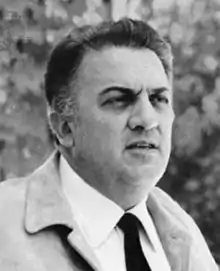
After the United States and the United Kingdom, Italy has the most Academy Awards wins.
Italy is the most awarded country at the Academy Award for Best Foreign Language Film, with 14 awards won, 3 Special Awards and 31 nominations. Winners with the year of the ceremony:
- Shoeshine (1947), by Vittorio De Sica (Honorary Award)
- Bicycle Thieves (1949), by Vittorio De Sica (Honorary Award)
- The Walls of Malapaga (1950), by René Clément (Honorary Award)
- La Strada (1956), by Federico Fellini
- Nights of Cabiria (1957), by Federico Fellini
- 8½ (1963), by Federico Fellini
- Yesterday, Today and Tomorrow (1964), by Vittorio De Sica
- Investigation of a Citizen Above Suspicion (1970), by Elio Petri
- The Garden of the Finzi-Continis (1971), by Vittorio De Sica
- Amarcord (1973), by Federico Fellini
- Cinema Paradiso (1989), by Giuseppe Tornatore
- Mediterraneo (1992), by Gabriele Salvatores
- Life Is Beautiful (1998), by Roberto Benigni
- The Great Beauty (2013), by Paolo Sorrentino
In 1961, Sophia Loren won the Academy Award for Best Actress for her role as a woman who is raped in World War II, along with her adolescent daughter, in Vittorio De Sica's Two Women. She was the first actress to win an Academy Award for a performance in any foreign language, and the second Italian leading lady Oscar-winner, after Anna Magnani for The Rose Tattoo. In 1998, Roberto Benigni was the first Italian actor to win for the Best Actor for Life Is Beautiful.

Italian-born filmmaker Frank Capra won three times at the Academy Award for Best Director, for It Happened One Night, Mr. Deeds Goes to Town and You Can't Take It with You. Bernardo Bertolucci won the award for The Last Emperor, and also Best Adapted Screenplay for the same movie.
Ennio De Concini, Alfredo Giannetti and Pietro Germi won the award for Best Original Screenplay for Divorce Italian Style. The Academy Award for Best Film Editing was won by Gabriella Cristiani for The Last Emperor and by Pietro Scalia for JFK and Black Hawk Down.
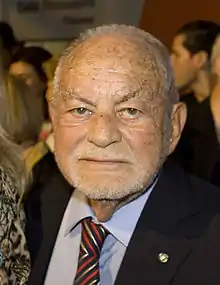
The award for Best Original Score was won by Nino Rota for The Godfather Part II; Giorgio Moroder for Midnight Express; Nicola Piovani for Life is Beautiful; Dario Marianelli for Atonement; and Ennio Morricone for The Hateful Eight. Giorgio Moroder also won the award for Best Original Song for Flashdance and Top Gun.
The Italian winners at the Academy Award for Best Production Design are Dario Simoni for Lawrence of Arabia and Doctor Zhivago; Elio Altramura and Gianni Quaranta for A Room with a View; Bruno Cesari, Osvaldo Desideri and Ferdinando Scarfiotti for The Last Emperor; Luciana Arrighi for Howards End; and Dante Ferretti and Francesca Lo Schiavo for The Aviator, Sweeney Todd: The Demon Barber of Fleet Street and Hugo.
The winners at the Academy Award for Best Cinematography are: Tony Gaudio for Anthony Adverse; Pasqualino De Santis for Romeo and Juliet; Vittorio Storaro for Apocalypse Now, Reds and The Last Emperor; and Mauro Fiore for Avatar.
The winners at the Academy Award for Best Costume Design are Piero Gherardi for La dolce vita and 8½; Vittorio Nino Novarese for Cleopatra and Cromwell; Danilo Donati for The Taming of the Shrew, Romeo and Juliet, and Fellini's Casanova; Franca Squarciapino for Cyrano de Bergerac; Gabriella Pescucci for The Age of Innocence; and Milena Canonero for Barry Lyndon, Chariots of Fire, Marie Antoinette and The Grand Budapest Hotel.
Special effects artist Carlo Rambaldi won three Oscars: one Special Achievement Academy Award for Best Visual Effects for King Kong[117] and two Academy Awards for Best Visual Effects for Alien[118] (1979) and E.T. the Extra-Terrestrial.[119] The Academy Award for Best Makeup and Hairstyling was won by Manlio Rocchetti for Driving Miss Daisy, and Alessandro Bertolazzi and Giorgio Gregorini for Suicide Squad.
Sophia Loren, Federico Fellini, Michelangelo Antonioni, Dino De Laurentiis, Ennio Morricone, and Piero Tosi also received the Academy Honorary Award.
Festivals

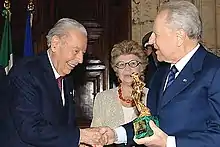
.jpg.webp)
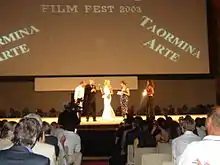
- Venice Film Festival, founded in 1932, is the world's oldest film festival and one of the "Big Three" film festivals, alongside the Cannes Film Festival and the Berlin International Film Festival.[120][121][122][123] The Big Three are internationally acclaimed for giving creators the artistic freedom to express themselves through film.[124] The most prestigious award given out at the Venice Film Festival is the Golden Lion, inspired by the Lion of Saint Mark, which was one of the best known symbols of the ancient Republic of Venice (697–1797).[125]
- David di Donatello, named after Donatello's David, a symbolic statue of the Italian Renaissance,[126] are film awards given out each year by the Accademia del Cinema Italiano (The Academy of Italian Cinema). Following the same criteria as the Academy Awards, the David di Donatello Awards (known by the moniker "Donatellos"[127]) were established in 1955 and first awarded in Rome on 5 July 1956.[128]
- Bari International Film Festival, is an annual film festival held since 2009 in Bari.[129]
- BigScreen Festival, is a film festival that focuses on Chinese and Italian cinema. It was first held in 2004 in Padua, Italy, but in 2006 moved to Kunming, Yunnan, China.
- Capri Hollywood International Film Festival, is an annual international film festival held every late December or early January in Capri
- Cartoons on the Bay, is an international festival held in Italy dedicated to television-, film- and transmedia- animation.[130][131][132][133] It is organised by the public service broadcaster RAI. The festival has been staged in Amalfi, Salerno,[134] Rapallo, Santa Margherita Ligure, Portofino, Positano,[135][136][137][138] Venice[139][140] and Turin.
- Ciak d'oro, is an Italian annual film award. It was established in 1986 by the magazine Ciak. It is the only award of Italian cinema that has the audience as jury:[141]
- Il Cinema Ritrovato, is organised every summer by the Cineteca di Bologna, and is the world's major festival of film restoration.[142]
- CinemadaMare Film Festival, is the annual film festival for youth amateur short movie makers that is held in Italy.
- Courmayeur Noir Film Festival, is a film noir film festival, held each December in Courmayeur.[143][144]
- Fantafestival, is a film festival devoted to science fiction, fantasy and horror film that has been held annually in Rome since 1981.[145]
- Far East Film Festival, is an annual film festival held in Udine, Italy. It is one of the most important events promoting Asian Cinema in Europe.[146]
- Festival del Cinema all'Aperto "Accordi @ DISACCORDI", is a film festival in Naples.
- Flaiano Prizes, are a set of Italian international awards recognizing achievements in the fields of creative writing, cinema, theater and radio-television.[147][148]
- Giffoni Film Festival, is one of the most well-known children's film festivals in the world.[149] It takes place in a small Italian town of Giffoni Valle Piana in Campania, Southern Italy, close to Salerno and Naples.
- Globo d'oro, is an Italian annual film award. It was established in 1960 and it has as jury the Rome Foreign Press Association.[150]
- Gran Paradiso Film Festival, is an International Nature and Environment Film Festival based in the Gran Paradiso National Park
- Grolla d'oro, is an Italian film awards held in Saint-Vincent.
- Io Isabella International Film Week, is the first film festival in the south of Italy, and the second in Italy, devoted to women and documentary filmmaking.
- Ischia Film Festival, is an annual film festival held in Ischia, Italy.[151]
- Italian Environmental Film Festival, is an Italian film festival founded in 1998 and taking place every year in Turin.
- Jalari in corto, is held annually at Parco Jalari in Barcellona Pozzo di Gotto.
- La Guarimba International Film Festival, is an international film festival that annually takes place in Amantea (Calabria) and which shows short films from all over the world, divided into the following categories: Fiction, Animation, Documentary, Insomnia, Music Video and La Grotta dei Piccoli – children's film selection.[152][153][154]
- Lucca Film Festival, is an annual event that has been held in Lucca since 2005.
- MedFilm Festival, is a film festival created in 1995 in Rome.
- Milan Film Festival, is an annual film festival held since 1996 in Milan.
- Napoli Film Festival, is a film festival that takes place every year since 1997 in Naples.[155]
- Nastro d'Argento, is an Italian film award awarded each year since 1946 by the Italian National Syndicate of Film Journalists (Italian: Sindacato Nazionale Giornalisti Cinematografici Italiani). It is the oldest Italian film award, given every year at the Teatro Antico in Taormina.[156][157]
- People and Religions – Terni Film Festival, is an international film festival, which takes place annually in November at the CityPlex Politeama Lucioli in Terni.
- Pordenone Silent Film Festival, is an annual festival of silent film held in October in Pordenone, northern Italy. It is the first, largest and most important international festival dedicated to silent film[158]
- Riviera International Film Festival, is an international film festival dedicated to filmmakers under 35 that takes place every year in Sestri Levante.
- Rome Film Festival, is a film festival that takes place in Rome during the month of October.
- Salerno Film Festival, is a film festival that takes place in Salerno.
- Sardinia International Ethnographic Film Festival, is an International Ethnographic film Festival based in Nuoro.
- Taormina Film Fest, is a film festival that takes place in Taormina.
- Torino Film Festival, is an international film festival held annually in Turin
- Trieste Film Festival, is an international film festival founded in 1989[159] and held annually on the third week of January in Trieste.
Auteurs
Italy has produced many important cinematography auteurs, including:
- Federico Fellini (1920–1993) is recognized as one of the greatest and most influential filmmakers of all time. His films have ranked highly in critical polls such as that of Cahiers du Cinéma and Sight & Sound, which lists his 1963 film 8+1⁄2 as the 10th-greatest film.
- Michelangelo Antonioni (1912–2007) films have been described as "enigmatic and intricate mood pieces"[160] that feature elusive plots, striking visual composition, and a preoccupation with modern landscapes.[161] His work would substantially influence subsequent art cinema.[162] Blow-Up is one of his best-known works.
- Roberto Rossellini (1906–1977) was one of the most prominent directors of the Italian neorealist cinema, contributing to the movement with films such as Rome, Open City (1945), Paisan (1946) and Germany, Year Zero (1948).
- Vittorio De Sica (1901–1974) was a leading figure in the neorealist movement. Four of the films he directed won Academy Awards: Sciuscià and Bicycle Thieves (honorary), while Yesterday, Today and Tomorrow and Il giardino dei Finzi Contini won the Academy Award for Best Foreign Language Film.
- Luchino Visconti (1906–1976) was a major figure of Italian art and culture in the mid-20th century, and he was one of the fathers of cinematic neorealism, but later moved towards luxurious, sweeping epics dealing with themes of beauty, decadence, death and European history – especially the decay of the nobility and the bourgeoisie was repeated several times in his films.
- Ettore Scola (1931–2016) received a Golden Globe for Best Foreign Film in 1978 for his film A Special Day and over the course of his film career was nominated for five Academy Awards for Best Foreign Language Film.
- Sergio Leone (1929–1989) credited as the creator of the Spaghetti Western genre[163][164] and widely regarded as one of the most influential directors in the history of cinema.[165][166][167][168]
- Luigi Comencini (1916–2007) was one of the masters of the Commedia all'Italiana (Comedy Italian style).
- Pier Paolo Pasolini (1922–1975) was a controversial personality in Italy due to his straightforward style, Pasolini's legacy remains partly contentious. He voiced strong criticism of petty bourgeois values and the emerging "totalitarianism of consumerism"[169] in Italy, juxtaposing socio-political polemics with a critical examination of taboo sexual matters.
- Bernardo Bertolucci (1941–2018) is considered one of the great filmmakers of the Italian cinema,[170][171] Bertolucci's work achieved widespread international acclaim. He was the first Italian filmmaker to win the Academy Award for Best Director[172] for The Last Emperor (1987), one of many accolades including two Golden Globes, two David di Donatellos, a British Academy Award, and a César Award.
- Franco Zeffirelli (1923–2019) movies included the romantic drama Romeo and Juliet (1968), for which he received a nomination for the Academy Award for Best Director, and his 1967 version of The Taming of the Shrew with Elizabeth Taylor and Richard Burton.
- Ermanno Olmi (1931–2018) best known film is The Tree of Wooden Clogs (L'Albero degli zoccoli), which was awarded the Palme d'Or at the 1978 Cannes Film Festival. The film drew heavily on Olmi's grandmother's stories about peasant life in agricultural regions of Italy.[173]
- Mario Monicelli (1915–2010) was one of the masters of the Commedia all'Italiana (Comedy Italian style). He was nominated six times for an Oscar, and was awarded the Golden Lion for his career.
- Marco Ferreri (1928–1997) is considered one of the greatest European cinematic provocateurs of his time[174] and had a constant presence in prestigious festival circuit – including eight films in competition in Cannes Film Festival[175] and a Golden Bear win[175] in 1991 Berlin Film Festival. Three of his films are among 100 films selected for preservation for significant contribution to Italian cinema.[176]
- Elio Petri (1929–1982) is best known for the 1970 Academy Award-winning film Investigation of a Citizen Above Suspicion.[177]
- Dino Risi (1916–2008) was one of the masters of the Commedia all'Italiana (Comedy Italian style).
- Lina Wertmüller (1928–2021), with Seven Beauties (1976), obtained four nominations for the Academy Awards, making her the first woman ever to receive a nomination for best director.[80] In 2019, Wertmüller was announced as one of four recipients of the Academy Honorary Award for her career,[178] the second female director to be so honoured.
- Francesco Rosi (1922–2015) film The Mattei Affair won the Palme d'Or at the 1972 Cannes Film Festival. At the 2008 Berlin International Film Festival 13 of his films were screened, in a section reserved for film-makers of outstanding quality and achievement. He received the Honorary Golden Bear for Lifetime Achievement, accompanied by the screening of his 1962 film Salvatore Giuliano. In 2012 the Venice Biennale awarded Rosi the Golden Lion for Lifetime Achievement.
- Florestano Vancini (1926–2008) 1966 film Le stagioni del nostro amore, starring Enrico Maria Salerno, was entered into the 16th Berlin International Film Festival.[179] His 1973 film The Assassination of Matteotti was entered into the 8th Moscow International Film Festival where it won a Special Prize.[180]
- Gillo Pontecorvo (1919–2006) worked as a film director for more than a decade before his best known film La battaglia di Algeri (The Battle of Algiers, 1966) was released. It won the Golden Lion at the Venice Film Festival in 1966.
- Luigi Magni (1928–2013) in 1977 achieved critical recognition with In nome del Papa Re, which also gave him his first David di Donatello Award.[181][182] He received a second David di Donatello in 1995, for the screenplay of Nemici d'infanzia, and a special David di Donatello Lifetime Career Award in 2008.[181][182]
- Pietro Germi (1914–1974) won the Grand Prize at the Cannes Film Festival for The Birds, the Bees and the Italians. His 1968 film Serafino won the Golden Prize at the 6th Moscow International Film Festival.[183]
- Paolo and Vittorio Taviani at the Cannes Film Festival won the Palme d'Or and the FIPRESCI prize for Padre Padrone in 1977 and Grand Prix du Jury for La notte di San Lorenzo (The Night of the Shooting Stars, 1982). In 2012 they won the Golden Bear at the Berlin International Film Festival with Caesar Must Die.
- Valerio Zurlini (1926–1982) 1962 film Family Diary earned him the Golden Lion at the Venice Film Festival (it tied with Tarkovsky's Ivan's Childhood). His 1965 film The Camp Followers was entered into the 4th Moscow International Film Festival where it won the Special Silver Prize.[184]
These directors' works often span many decades and genres. Present auteurs include:
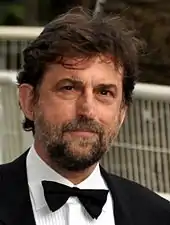
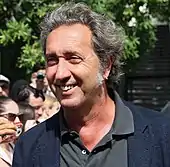
- Giuliano Montaldo (1930) in 1965 he wrote and directed Una bella grinta, a cynical representation of the economic boom of Italy, winning the Special Prize of the Jury at 15th Berlin International Film Festival. In 1982 he directed the television miniseries Marco Polo, which won the Emmy Award for Outstanding Miniseries.
- Ruggero Deodato (1939) career has spanned a wide-range of genres including peplum, comedy, drama, poliziottesco and science fiction, yet he is perhaps best known for directing violent and gory horror films with strong elements of realism. Deodato has been an influence on film directors like Oliver Stone, Quentin Tarantino and Eli Roth.[185][186]
- Giuseppe Tornatore (1956) is considered one of the directors who brought critical acclaim back to Italian cinema.[10] Probably his most noted film is Cinema Paradiso, for which Tornatore won the Academy Award for Best Foreign Language Film.
- Marco Bellocchio (1939) in 1991 won the Silver Bear – Special Jury Prize at the 41st Berlin International Film Festival for his film The Conviction.[187]
- Nanni Moretti (1953) films have won accolades including a Palme d'Or at the 2001 Cannes Film Festival for The Son's Room, a Silver Bear at the 1986 Berlin Film Festival for The Mass Is Ended and a Silver Lion at the 1981 Venice Film Festival for Sweet Dreams, in addition to the David di Donatello Award for Best Film on three separate occasions (for Caro diario in 1994, The Son's Room in 2001 and Il caimano in 2006).
- Gabriele Salvatores (1950) in 1991 received international praise for Mediterraneo, which won an Academy Award as best foreign film.[188] It also won three David di Donatello, the most important award for Italian cinema, and a Silver Ribbon.
- Gianni Amelio (1945) 1989 film Open Doors (Porte aperte), featuring Gian Maria Volonté, confirmed his status as one of Italy's best film directors and won a nomination as Best Foreign Film at 1991 Academy Awards. The film received also four Felix, two Silver Ribbon, four David di Donatello and three Golden Globes awards.
- Dario Argento (1940) work in the horror genre during the 1970s and 1980s, particularly in the subgenre known as giallo, has led him to being referred to as the "Master of the Thrill"[189] and the "Master of Horror".[190]
- Paolo Sorrentino (1970) 2013 film La Grande Bellezza won the Academy Award, the Golden Globe, and the Bafta Award for Best Foreign Language Film.[191] In Italy he was honoured with five David di Donatello and six Nastro d'Argento. He also directed the international co-production Youth, which won Best Film at the European Film Awards and earned him a win for Best Director.
- Matteo Garrone (1968) won Best Director at the European Film Awards and at the David di Donatello Awards for Gomorrah (2008), among many other awards. His film Reality (2012) competed in competition at the 2012 Cannes Film Festival[192][193] and won the Grand Prix.[194]
- Marco Tullio Giordana (1950) film Quando sei nato non puoi più nasconderti was entered into the 2005 Cannes Film Festival.[195]
- Paolo Virzì (1964) film Ovosodo won in 1997 the Jury Grand Prix of the Venice International Film Festival.
- Mario Martone (1959) film L'amore molesto was entered into the 1995 Cannes Film Festival.[196] His 2010 film Noi credevamo competed for the Golden Lion at the 67th Venice International Film Festival.[197]
- Gianfranco Rosi (1963) 2013 film Sacro GRA won the Golden Lion at the 70th Venice Film Festival, while his 2016 film Fire at Sea won the Golden Bear at the 66th Berlin Film Festival.
- Luca Guadagnino (1971) for directing and producing Call Me by Your Name (2017), received widespread critical acclaim and several accolades, including nominations for the Academy Award for Best Picture, Nastro d'Argento for Best Director, BAFTA Award for Best Direction and Best Film, and Golden Globe Award for Best Motion Picture – Drama.
Actors and actresses

.tif.jpg.webp)
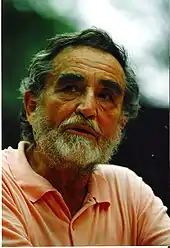
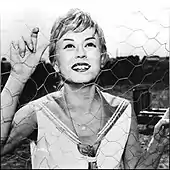

- Alida Valli was an Italian actress who appeared in more than 100 films in a 70-year career, spanning from the 1930s to the early 2000s. She was one of the biggest stars of Italian film during the Fascist era, once being coined "the most beautiful woman in the world" by Benito Mussolini, but managed to find continued international success post-World War II.[198][199] According to Frédéric Mitterrand, Valli was the only actress in Europe to equal Marlene Dietrich or Greta Garbo.
- Alberto Sordi won seven David di Donatello, Italy's most prestigious film award, holding the record of David di Donatello as best actor, and four awards for his works from the Italian National Syndicate of Film Journalists. He also received a Golden Lion for lifetime achievement at the Venice Film Festival in 1995, and The Golden Globe Award[200] for his performance as an Italian labourer stranded in Sweden in To Bed or Not to Bed. At the 22nd Berlin International Film Festival, he won the Silver Bear for Best Actor award for Detenuto in attesa di giudizio.[201] At the 13th Moscow International Film Festival he won a Special Prize for I Know That You Know That I Know.[202]
- Alvaro Vitali was an electrician until he was discovered by Federico Fellini and played a small part in Satyricon (1969), it led to other roles, notably in the movie Amarcord (1973). In the 1970s, Vitali became one of the most charismatic actors in the commedia erotica all'italiana (erotic comedy) genre.
- Anna Magnani was known for her explosive acting and earthy, realistic portrayals of characters. Time described her personality as "fiery", and drama critic Harold Clurman said her acting was "volcanic". In the realm of Italian cinema, she was "passionate, fearless, and exciting," an actress whom film historian Barry Monush calls "the volcanic earth mother of all Italian cinema."[203] Director Roberto Rossellini called her "the greatest acting genius since Eleonora Duse".[204] She was also the first Italian actor (either male or female) to win an Academy Award in an acting category, for her performance in The Rose Tattoo.
- Bud Spencer was known for action-comedy and Spaghetti Western roles with his long-time film partner Terence Hill. The duo "garnered world acclaim and attracted millions to theater seats".[205] Spencer and Hill appeared in, produced and directed over 20 films together.
- Claudia Cardinale is a Tunisian-born Italian film actress who starred in some of the most acclaimed European films of the 1960s and 1970s, mainly Italian or French, but also in many English-language films.
- Elio Germano is the recipient of many accolades, including a Cannes Film Festival Award for Best Actor and a Silver Bear for Best Actor.
- Giancarlo Giannini is an Italian actor, voice actor, film director and screenwriter.[206] He won a Cannes Film Festival Award for Best Actor for his performance in Love and Anarchy (1973) and received an Academy Award for Best Actor nomination for his performance in Seven Beauties (1975).
- Gino Cervi was best known for his role of Giuseppe Bottazzi ("Peppone"), the Communist mayor in the Don Camillo movies of the 1950s and the 1960s. He shared great understanding and friendship with co-star Fernandel during the 15 years playing their respective roles in Don Camillo movies.[207] Toward the end of his career he played Commissioner Maigret for eight years in the Italian TV adaptation of the celebrated series of crime novels by Georges Simenon, Le inchieste del commissario Maigret (1964–1972), during which he also starred in a spin-off movie Maigret a Pigalle (Mario Landi, 1966), produced by his son Antonio Cervi.[208]
- Gian Maria Volonté was remembered for his versatility as an interpreter, his outspoken left-wing leanings and fiery temper on and off-screen. He is perhaps most famous outside Italy for his roles in four Spaghetti Western films: Ramón Rojo and El Indio in Sergio Leone's A Fistful of Dollars (1964) and For a Few Dollars More (1965), El Chuncho Munoz in Damiano Damiani's A Bullet for the General (1966) and Professor Brad Fletcher in Sergio Sollima's Face to Face (1967).
- Gina Lollobrigida was one of the highest-profile European actresses of the 1950s and early 1960s, a period in which she was an international sex symbol. As of 2022, Lollobrigida is among the last living, high-profile international actors from the Golden Age of Hollywood cinema.
- Giovanna Mezzogiorno is the principal female character from Love in the Time of Cholera based on the book written by Nobel Prize winner Gabriel García Márquez and directed by Mike Newell (Four Weddings and a Funeral). After two films shot in 2008, Sono Viva and Palermo Shooting by Wim Wenders, in 2009 she achieved great international success with Vincere by Marco Bellocchio, selected for the official competition in Cannes and a solid candidate for the final award.
- Giuliano Gemma is best known internationally for his work in Spaghetti Westerns, particularly for his performances as the title character in Duccio Tessari's A Pistol for Ringo (1965), Captain Montgomery Brown/'Ringo' in Tessari's The Return of Ringo (1965), the title character in Michele Lupo's Arizona Colt (1966), Scott Mary in Tonino Valerii's Day of Anger (1967) and Michael "California" Random in Lupo's California (1977).
- Giulietta Masina was an Italian film actress, best known for her performances of Gelsomina in La Strada (1954) and Cabiria in Nights of Cabiria (1957). Cinema historian Peter Bondanella described Masina's work as "masterful" and "unforgettable,"[209] and Charlie Chaplin, with whose work Masina's is often compared,[210][211][212] called her "the actress who moved him most." Both La Strada and Nights of Cabiria won Academy Awards for Best Foreign Language Film and were described as having been "inspired" by Masina's "humanity."[213]
- Isabella Rossellini is an Italian-American actress, author, philanthropist, and model. The daughter of the Swedish actress Ingrid Bergman and the Italian film director Roberto Rossellini, she is noted for her successful tenure as a Lancôme model, and for her roles in films such as Blue Velvet (1986) and Death Becomes Her (1992). Rossellini received a Golden Globe Award nomination for her performance in Crime of the Century (1996).
- Massimo Troisi was an Italian actor, cabaret performer, screenwriter, and film director. He is best known for his works in the films I'm Starting from Three (1981) and Il Postino: The Postman (1994), for which he was posthumously nominated for two Oscars. Nicknamed "the comedian of feelings,"[214] he is considered one of the most important actors of Italian theater and cinema.[215]
- Marcello Mastroianni was an Italian film actor, regarded as one of Italy's most iconic male performers of the 20th century. A pet actor of five-time Academy Award-winning director Federico Fellini, he starred in such films as La Dolce Vita; 8½; La Notte; Divorce Italian Style; Yesterday, Today and Tomorrow; Marriage Italian Style; The 10th Victim; A Special Day; City of Women; Henry IV, and Everybody's Fine. His honours included 2 BAFTAs, 2 Best Actor awards at the Venice and Cannes film festivals, 2 Golden Globes, and 3 Oscar nominations.
- Monica Bellucci played a Bride of Dracula in Francis Ford Coppola's gothic horror romance film Bram Stoker's Dracula (1992) and she was in the controversial Gaspar Noé arthouse horror film Irréversible (2002), and portrayed Mary Magdalene in Mel Gibson's biblical drama The Passion of the Christ (2004).
- Monica Vitti was an Italian actress best known for her starring roles in films directed by Michelangelo Antonioni during the early-to-mid 1960s.[216] After working with Antonioni, Vitti changed focus and began making comedies, working with director Mario Monicelli on many films. She has appeared with Marcello Mastroianni, Alain Delon, Richard Harris, Terence Stamp, Michael Caine, and Dirk Bogarde. Vitti won five David di Donatello Awards for Best Actress, seven Italian Golden Globes for Best Actress, the Career Golden Globe, and the Venice Film Festival Career Golden Lion Award.[217]
- Nino Manfredi was an Italian actor, voice actor, director, screenwriter, playwright, comedian, singer, author, radio personality and television presenter.[218] He was one of the most prominent Italian actors in the commedia all'italiana genre. During his career he won several awards, including six David di Donatello awards, six Nastro d'Argento awards and the Prix de la première oeuvre (Best First Work Award) at the 1971 Cannes Film Festival for his performance in Between Miracles.[182] Typically playing losers, marginalised, working-class characters yet "in possession of their dignity, morality, and underlying optimism",[219] he was referred to as "one of the few truly complete actors in Italian cinema".[219]
- Ornella Muti made her English-speaking film debut as Princess Aura in Flash Gordon in 1980.[220] American movie she appeared in include Oscar (1991) directed by John Landis.[220]
- Pierfrancesco Favino has appeared in more than fifty European and American movies and television series since the early 1990s. In 2020, he won the Volpi Cup at Venice Film Festival for his performance in Padrenostro.
- Raoul Bova European film breakthrough was in the 1993 film Piccolo grande amore, and he's played romantic male leads the following years. His American film credits include Under the Tuscan Sun (2003), Alien vs. Predator (2004) and The Tourist (2010). He won the Golden Globe Award for Best Actor in 2007 for his performance in I, the Other and 2011 for his performance in Escort in Love.
- Roberto Benigni is an Italian actor, comedian, screenwriter and director. He gained international recognition for writing, directing and starring in the Holocaust comedy-drama film Life Is Beautiful (1997), for which he received the Academy Awards for Best Actor (the first for a non-English speaking male performance) and Best International Feature Film.
- Sophia Loren was named by the American Film Institute as one of the greatest female stars of Classical Hollywood cinema.[221] As of 2022, Loren is one of the last surviving major stars from the Golden Age of Hollywood cinema and the only living person on AFI's list. She also became the second italian actor (either male or female) to win an acting Academy Award, for her performance in Two Women.
- Stefano Accorsi in 1998 won three prizes for his role in Radiofreccia, directed by rock star Luciano Ligabue, including David di Donatello for Best Actor. In 2017 he won the David di Donatello for Best Actor for his performance in Italian Race, while in 2002 he won the Volpi Cup for Best Actor at Venice Film Festival for his performance in A Journey Called Love.
- Totò was commonly referred to as one of the most popular Italian performers of all time. He is best known for his funny and sometimes cynical character as a comedian in theatre and then in many successful films shot from the 1940s to the 1960s, all regularly still on TV, but he also worked with many iconic Italian film directors in dramatic/poetic roles.[222]
- Ugo Tognazzi after the successful role in The Fascist (Il Federale) (1961), directed by Luciano Salce, he became one of the most renowned characters of the so-called Commedia all'Italiana (Italian comedy style). He worked with all the main directors of Italian cinema, including Mario Monicelli (Amici miei), Marco Ferreri (La grande abbuffata), Carlo Lizzani (La vita agra), Dino Risi, Pier Paolo Pasolini (Pigsty), Ettore Scola, Alberto Lattuada, Nanni Loy, Pupi Avati and others.
- Valeria Golino is best known to English-language audiences for her roles in Rain Man, Big Top Pee-wee and the two Hot Shots! films, particularly the olive-in-the-belly-button scene. In addition to David di Donatello, Silver Ribbon, Golden Ciak and Italian Golden Globe awards, she is one of three actresses to have twice won the Best Actress award at the Venice Film Festival.
- Virna Lisi's international film appearances included How to Murder Your Wife (1965), Not with My Wife, You Don't! (1966), The Secret of Santa Vittoria (1969), Beyond Good and Evil (1977), and Follow Your Heart (1996). For the 1994 film La Reine Margot, she won Best Actress at Cannes and the César Award for Best Supporting Actress.
- Vittorio Gassman is considered one of the greatest Italian actors, whose career includes both important productions as well as dozens of divertissements.[223] With Alberto Sordi, Ugo Tognazzi and Nino Manfredi, Gassman is considered one of the greatest interpreters of the Commedia all'italiana,[224][225] a quartet which Marcello Mastroianni and Monica Vitti are generally associated with.[226][227]
See also
- Media of Italy
- Cinema of the world
- History of cinema
- List of actors from Italy
- List of actresses from Italy
- List of film directors from Italy
- List of Italian movies
- List of highest-grossing films in Italy
Notes
- From top left to bottom right: Vittorio De Sica, Sophia Loren, Marcello Mastroianni, Pier Paolo Pasolini, Roberto Rossellini, Sergio Leone, Nino Manfredi, Luchino Visconti, Alberto Sordi, Totò, Gina Lollobrigida, Claudia Cardinale, Anna Magnani, Roberto Benigni, Michelangelo Antonioni, Giancarlo Giannini, Ugo Tognazzi, Bud Spencer, Isabella Rossellini, Federico Fellini, Mario Monicelli, Virna Lisi, Ettore Scola, Alvaro Vitali, and Monica Bellucci
References
- "Table 8: Cinema Infrastructure – Capacity". UNESCO Institute for Statistics. Archived from the original on 5 November 2013. Retrieved 5 November 2013.
- "Table 6: Share of Top 3 distributors (Excel)". UNESCO Institute for Statistics. Archived from the original on 24 December 2018. Retrieved 5 November 2013.
- "Tutti i numeri del cinema italiano 2018" (PDF). ANICA.
- "Country Profiles". Europa Cinemas. Archived from the original on 9 November 2013. Retrieved 9 November 2013.
- Peter Bondanella (2009). A History of Italian Cinema. A&C Black. ISBN 9781441160690.
- Luzzi, Joseph (30 March 2016). A Cinema of Poetry: Aesthetics of the Italian Art Film. ISBN 9781421419848.
- "L'œuvre cinématographique des frères Lumière – Pays: Italie" (in French). Archived from the original on 20 March 2018. Retrieved 1 January 2022.
- "Il Cinema Ritrovato – Italia 1896 – Grand Tour Italiano" (in Italian). Archived from the original on 21 March 2018. Retrieved 1 January 2022.
- Gino Moliterno (2009). The A to Z of Italian Cinema (in Italian). Scarecrow Press. p. 243. ISBN 978-0-8108-7059-8.
- Ephraim Katz (2001), "Italy", The Film Encyclopedia, HarperResource, pp. 682–685
- David Bruni (2013). Roberto Rossellini: Roma città aperta (in Italian). Lindau. ISBN 978-88-6708-221-6.
- Silvia Bizio; Claudia Laffranchi (2002). Gli italiani di Hollywood: il cinema italiano agli Academy Awards (in Italian). Gremese Editore. ISBN 978-88-8440-177-9.
- Alessandro Chiello (2014). C'eravamo tanto amati. I capolavori e i protagonisti del cinema italiano (in Italian). Alessandro Chiello. ISBN 978-605-03-2773-1.
- Alessandro Grande (2013). La produzione del cinema italiano oggi (in Italian). Lulu.com. ISBN 978-1-4092-5750-9.
- Monica Repetto (2000). La vita è bella?: il cinema italiano alla fine degli anni Novanta e il suo pubblico (in Italian). Il castoro. ISBN 978-88-8033-163-6.
- Franco Montini (2002). Il cinema italiano del terzo millennio: i protagonisti della rinascita (in Italian). Il castoro. ISBN 978-88-7180-428-6.
- "I migliori film italiani: gli anni 2000" (in Italian). Retrieved 14 January 2022.
- "La Biennale di Venezia – The origin". 7 April 2017. Retrieved 9 September 2018.
- "26 febbraio 1896 – Papa Leone XIII filmato Fratelli Lumière" (in Italian). Retrieved 1 January 2022.
- "31 dicembre 1847: nasce a Torino Vittorio Calcina" (in Italian). Retrieved 2 January 2022.
- "Cineteca: pericolosa polveriera per 50 anni di cinema italiano" (in Italian). Retrieved 13 January 2022.
- Valerio Angelini; Fiorangelo Pucci (1981). 1896–1914 Materiali per una storia del cinema delle origini (in Italian). Studio Forma.
... allo stato attuale delle ricerche, la prima proiezione nelle Marche viene ospitata al Caffè Centrale di Ancona: ottobre 1896
[... The present state of research, the first screening will be hosted in the Marches of Ancona at the Café Central: October 1896] - "Storia del cinema italiano" (in Italian). Retrieved 9 January 2022.
- "Fernaldo Di Giammatteo (1999), "Un raggio di sole si accende lo schermo", in I Cineoperatori. La storia della cinematografia italiana dal 1895 al 1940 raccontata dagli autori della fotografia (volume 1°)" (PDF) (in Italian). Archived from the original (PDF) on 29 September 2013. Retrieved 9 January 2022.
- "Italo Pacchioni alle Giornate del Cinema Muto 2009" (in Italian). 25 September 2009. Retrieved 21 January 2016.
- "CRITICA CINEMATOGRAFICA" (in Italian). Retrieved 5 January 2022.
- Gian Piero Brunetta (2003). Guida alla storia del cinema italiano. 1905–2003 (in Italian). Einaudi. p. 425.
- Elisabetta Bruscolini (2003). Roma nel cinema tra realtà e finzione (in Italian). Fondazione Scuola Nazionale di Cinema. p. 18.
- "Riprese degli operatori Lumière a Torino – Enciclopedia del cinema in Piemonte" (in Italian). Retrieved 5 January 2022.
- Baretta, Marcello (22 July 2016). High Concept Movie (in Italian). ISBN 9788889991190. Retrieved 9 January 2022.
- "Italo Pacchioni alle Giornate del Cinema Muto 2009" (in Italian). Retrieved 5 January 2022.
- Roberto Della Torre (2014). Invito al cinema. Le origini del manifesto cinematografico italiano (in Italian). Educatt. p. 78.
- Gian Piero Brunetta (2002). Storia del cinema mondiale (in Italian). Vol. III. Einaudi. p. 40. ISBN 978-88-06-14528-6.
- "Cinematografia", Dizionario enciclopedico italiano (in Italian), vol. III, Treccani, 1970, p. 226
- Gian Piero Brunetta (2002). Storia del cinema mondiale (in Italian). Vol. III. Einaudi. p. 38. ISBN 978-88-06-14528-6.
- Welle, John P. (2004). "Early Cinima, Dante's Inferno of 1911, and the Origins of Italian Film Culture". In Iannucci, Amilcare A. (ed.). Dante, Cinema, and Television. University of Toronto Press. pp. 36, 38–40. ISBN 0-8020-8827-9.
- Hall, Sheldon; Neale, Steve (2010). Epics, Spectacles and Blockbusters: A Hollywood History. Wayne State University Press. p. 31. ISBN 978-0-8143-3008-1.
- Andrea Fioravanti (2006). La "storia" senza storia. Racconti del passato tra letteratura, cinema e televisione (in Italian). Morlacchi Editore. p. 121. ISBN 978-88-6074-066-3.
- Robert K. Klepper (1999). Silent Films, 1877-1996: A Critical Guide to 646 Movies. McFarland. p. 78. ISBN 978-0-7864-0595-4.
- Patrick Robertson (1991). Guinness Book of Movie Facts and Feats. Abbeville Press. p. 217. ISBN 978-1-55859-236-0.
- John Alberti (2014). Screen Ages: A Survey of American Cinema. Routledge. p. 45. ISBN 978-1-317-65028-7.
- "La bellezza del cinema" (in Italian). Retrieved 9 January 2022.
- Gian Piero Brunetta (2002). Storia del cinema mondiale (in Italian). Vol. III. Einaudi. p. 51. ISBN 978-88-06-14528-6.
- The 20th-Century art book (Reprinted. ed.). dsdLondon: Phaidon Press. 2001. ISBN 978-0714835426.
- Steve Ricci (2008). Cinema and Fascism: Italian Film and Society, 1922–1943. University of California Press. p. 4. ISBN 9780520941281.
- Gian Piero Brunetta (2002). Storia del cinema mondiale (in Italian). Vol. I. Einaudi. p. 245. ISBN 978-88-06-14528-6.
- Gian Piero Brunetta (2002). Storia del cinema mondiale (in Italian). Vol. III. Einaudi. p. 57. ISBN 978-88-06-14528-6.
- "Cinecittà, c'è l'accordo per espandere gli Studios italiani" (in Italian). Retrieved 10 September 2022.
- "The Cinema Under Mussolini". Ccat.sas.upenn.edu. Archived from the original on 31 July 2010. Retrieved 30 October 2010.
- "Vittorio De Sica: l'eclettico regista capace di fotografare la vera Italia" (in Italian). 6 July 2020. Retrieved 14 January 2022.
- Ronald Bergan (2011). The Film Book. Penguin. p. 154. ISBN 9780756691882.
- Steve Ricci (2008). Cinema and Fascism: Italian Film and Society, 1922–1943. University of California Press. p. 169. ISBN 9780520941281.
- "Umberto D (regia di Vittorio De Sica, 1952, 89', drammatico)" (in Italian). Retrieved 9 January 2022.
- Ebert, Roger. "The Bicycle Thief / Bicycle Thieves (1949)". Chicago Sun-Times. Retrieved 8 September 2011.
- Shapiro, Michael J. (1 August 2008). "Slow Looking: The Ethics and Politics of Aesthetics: Jill Bennett, Empathic Vision: Affect, Trauma, and Contemporary Art (Stanford, CA: Stanford University Press, 2005); Mark Reinhardt, Holly Edwards, and Erina Duganne, Beautiful Suffering: Photography and the Traffic in Pain (Chicago, IL: University of Chicago Press, 2007); Gillo Pontecorvo, director, The Battle of Algiers (Criterion: Special Three-Disc Edition, 2004)". Millennium: Journal of International Studies. 37: 181–197. doi:10.1177/0305829808093770.
- Gian Piero Brunetta (2002). Storia del cinema mondiale (in Italian). Vol. III. Einaudi. pp. 357–359. ISBN 978-88-06-14528-6.
- Andrea Martini (1992). La bella forma. Poggioli, i calligrafici e dintorni. Marsilio. ISBN 88-317-5774-1.
- "IL CINEMA IN ITALIA NEGLI ANNI '50" (in Italian). Retrieved 9 January 2022.
- Aldo Tassone (2002). I film di Michelangelo Antonioni: un poeta della visione (in Italian). Gremese editore.
- "Il miglior film di tutti i tempi: "Il Padrino" o "8 e mezzo"?" (in Italian). Retrieved 14 January 2022.
- Bondanella, Peter (2002). The Films of Federico Fellini. Cambridge: Cambridge University Press. p. 8. ISBN 978-0-511-06572-9.
- Ennio Flaiano, the film's co-screenwriter and creator of Paparazzo, explained that he took the name from Signor Paparazzo, a character in George Gissing's novel By the Ionian Sea (1901). See Peter Bondanella (1994). The Cinema of Federico Fellini. Guaraldi. p. 136.
- "Tim Burton Collective". Archived from the original on 16 June 2007.
- "Gilliam at Senses of Cinema". Archived from the original on 9 February 2010. Retrieved 13 January 2022.; accessed 17 September 2008.
- Kusturica Interview at BNET; accessed 17 September 2008.
- "City of Absurdity Quote Collection". Retrieved 17 September 2008.
- "Europe Choosey on Films, Sez Reiner; Sluffs Flops". Variety. 9 September 1953. p. 7. Retrieved 29 September 2019 – via Archive.org.
- "1953 at the box office". Box Office Story.
- Richard Wrigley (2008). Cinematic Rome. Troubador Publishing. p. 52.
- Hotz, Stephanie Aneel (2017). The Italian musicarello : youth, gender, and modernization in postwar popular cinema – Texas Scholar Works (Thesis). doi:10.26153/tsw/2764. Retrieved 15 January 2022.
- Lino Aulenti (2011). Storia del cinema italiano. libreriauniversitaria, 2011. ISBN 978-8862921084.
- Giuliano Pavone (1999). Giovannona Coscialunga a Cannes. Tarab.
- "Spaghetti western star Bud Spencer dies". BBC News. 28 June 2016.
He frequently appeared as part of a double act alongside Terence Hill
- "Stasera in tv su Iris alle 01,25 Cannibal Ferox di Umberto Lenzi con Giovanni Lombardo Radice" (in Italian). 25 August 2017. Retrieved 15 January 2022.
- "Violent Italy: A Poliziotteschi Primer". 13 September 2015. Retrieved 13 January 2022.
- Curti, Roberto (2013). Italian Crime Filmography, 1968–1980. McFarland. ISBN 9781476612089.
- "Franco e Ciccio – Una coppia in fotografia – La Storia siamo noi" (in Italian). Archived from the original on 14 September 2018. Retrieved 14 September 2018.
- "MORTO FRANCO FRANCHI UNA CARRIERA PER RIDERE – la Repubblica.it" (in Italian). Retrieved 14 September 2018.
- "Una piazza per Franco e Ciccio amarcord tra vicoli e teatrini – Palermo – Repubblica.it" (in Italian). 11 December 2012. Retrieved 14 September 2018.
- "Lina Wertmuller: "Agli Oscar credo poco, preferisco pensare al nuovo film"" (in Italian). 21 September 2015. Retrieved 5 January 2022.
- Paolo Mereghetti (2011). Dizionario dei film 2011 (in Italian). B.G Dalai editore. p. 1423. ISBN 978-88-6073-626-0.
- For a continuation of this kind in the 2000s, see "Cinema & cinema: "La tenerezza" di Gianni Amelio", according to which "The tenderness" of Amelio "refers to the whole of Italy affected by corruption inveterate by frustrations without escape from racist hatred: it refers to that sense of death, of paralysis, of the lack of ideal perspectives, which Italian films have incessantly recorded for years ".
- "Il Cinema Politico – Treccani" (in Italian). Retrieved 5 January 2022.
- Paolo Mereghetti (2011). Dizionario dei film 2011 (in Italian). B.G Dalai editore. p. 1654. ISBN 978-88-6073-626-0.
- "CantaNapoli: La sceneggiata di Mario Merola". July 2020. Retrieved 15 January 2022.
- "Nino D'Angelo: uno show per i suoi 60 anni. L'intervista". 13 June 2017. Retrieved 15 January 2022.
- "Ennio Morricone compie novant'anni, cinque cose che non sapete sul genio italiano della colonna sonora" (in Italian). Retrieved 14 January 2022.
- Vito Zagarrio (2005). Storia del cinema italiano 1977/1985 (in Italian). Marsilio. p. 329.
- Vito Zagarrio (2005). Storia del cinema italiano 1977/1985 (in Italian). Marsilio. p. 348.
- "Italia 80" (in Italian). 4 October 2012. Retrieved 9 January 2022.
- Rooney, David (7 January 2002). "Local yokels deliver a boffo B.O holiday gift". Variety. p. 30.
- Vitti, Antonio (2012). "Introduzione. Cinema italiano contemporaneo". Annali d'Italianistica (in Italian). 30: 17–29. JSTOR 24017598. Retrieved 9 January 2022.
- Paolo D'Agostini. "Il cinema italiano da Moretti a oggi". Storia del cinema mondiale (in Italian). pp. 1102–1103.
- "Pieraccioni, Leonardo". Treccani Encyclopedia. Retrieved 21 January 2020.
- "E Il Ciclone, film record, va in tv". la Repubblica. 23 October 1999. Retrieved 21 January 2020.
- "Vent'anni dopo Il Ciclone è un cult. Pieraccioni lo celebra tra Conti e Panariello". la Repubblica. 3 September 2016. Retrieved 21 January 2020.
- "FILM ITALIANI 1995" (in Italian). Retrieved 22 January 2022.
- "FILM ITALIANI 2005" (in Italian). Retrieved 22 January 2022.
- "RAPPORTO – Il Mercato e l'Industria del Cinema in Italia – 2008" (PDF) (in Italian). Retrieved 22 January 2022.
- "'Perfetti Sconosciuti' da Guinness, la commedia di Genovese è il film con più remake di sempre". Repubblica Tv – la Repubblica.it (in Italian). 15 July 2019. Retrieved 16 July 2019.
- Anderson, Ariston (4 January 2016). "Italy Box Office: Local Hit 'Quo Vado?' Sets Opening Records". The Hollywood Reporter. Retrieved 4 January 2016.
- Lyman, Eric J. (4 November 2013). "Italian Comedy 'Sun in Buckets' Sets New Opening Weekend Sales Record". The Hollywood Reporter. Retrieved 4 January 2016.
- Anderson, Ariston (26 September 2016). "Oscars: Italy Selects 'Fire at Sea' for Foreign-Language Category". The Hollywood Reporter. Retrieved 26 September 2016.
- "CINETECA NAZIONALE DI ROMA" (in Italian). Retrieved 9 January 2022.
- "Cineteca" (in Italian). Retrieved 6 January 2022.
- "Centro Sperimentale di Cinematografia" (in Italian). Retrieved 6 January 2022.
- "Cineteca Nazionale". Archived from the original on 19 March 2014. Retrieved 17 January 2022.
{{cite web}}: CS1 maint: bot: original URL status unknown (link) - "Fondazione Cineteca Italiana (FCI) — filmarchives online" (in Italian). Retrieved 1 June 2016.
- "1962, nasce la Cineteca di Bologna: 53 anni di storia in un video" (in Italian). Retrieved 17 January 2022.
- "Touring Club Italiano – Dossier Musei 2009" (PDF) (in Italian). Archived from the original (PDF) on 18 April 2012. Retrieved 16 January 2022.
- "MUSEO NAZIONALE DEL CINEMA – MOLE ANTONELLIANA" (in Italian). Retrieved 16 January 2022.
- "Museo del Cinema di Roma" (in Italian). Retrieved 17 January 2022.
- "MUSEO INTERATTIVO DEL CINEMA DI MILANO" (in Italian). Retrieved 17 January 2022.
- "Museo del Cinema di Catania" (in Italian). Retrieved 17 January 2022.
- "Museo del Cinema di Siracusa" (in Italian). Retrieved 17 January 2022.
- "Dino De Laurentiis". IMDb. Retrieved 21 January 2022.
- "49th Academy Awards (Monday, March 28, 1977)". Retrieved 13 January 2022.
- "52nd Academy Awards (Monday, April 14, 1980)". Retrieved 13 January 2022.
- "55th Academy Awards (Monday, April 11, 1983)". Retrieved 13 January 2022.
- Anderson, Ariston (24 July 2014). "Venice: David Gordon Green's 'Manglehorn,' Abel Ferrara's 'Pasolini' in Competition Lineup". The Hollywood Reporter. Archived from the original on 18 February 2016.
- Valck, Marijke de; Kredell, Brendan; Loist, Skadi (26 February 2016). Film Festivals: History, Theory, Method, Practice. ISBN 9781317267218.
- "Addio, Lido: Last Postcards from the Venice Film Festival". Time. Retrieved 9 September 2018.
- "50 unmissable film festivals". Variety. 8 September 2007. Retrieved 23 June 2020.
- Chan, F. (1 June 2011). "The international film festival and the making of a national cinema". Screen. 52 (2): 253–260. doi:10.1093/screen/hjr012.
- "L'ICONOGRAFIA DEL LEONE DI SAN MARCO" (in Italian). Retrieved 20 January 2022.
- "Trionfante e sereno nella sua nudità, David, simbolo del Rinascimento" (in Italian). Retrieved 21 January 2022.
- "Oscar's Foreign Cousins". Variety. Variety Media. 9 December 1998. Retrieved 26 March 2016.
- Laviosa, Flavia (29 January 2015). "David di Donatello 1956–2016: Sixty Years of Awards" [Call for Papers] (PDF). Journal of Italian Cinema and Media Studies. Intellect. Archived from the original (PDF) on 17 October 2016. Retrieved 25 March 2016.
- Caprara, Fulvia (12 April 2017). "Da Konchalovskij ad Ardant e Avati: tante le novità del Bari International Film Festival". La Stampa (in Italian). Retrieved 14 November 2017.
- "Nelvana.com : Company : Awards Received". Nelvana. Archived from the original on 23 July 2010. Retrieved 13 August 2010.
- "Cartoons on the Bay: Special Awards 2009". Archived from the original on 24 July 2011. Retrieved 20 January 2022.
- "Cartoons on the Bay 1999". Cartoonsbay.com. Archived from the original on 26 October 2006. Retrieved 10 August 2015.
- "Consegnati i Pulcinella Awards" (in Italian). Fanatic About Festivals. 26 April 2004. Retrieved 7 June 2019.
- "Cartoons on the Bay – A Film Festival World profile". Film Festival World. Archived from the original on 24 December 2011. Retrieved 5 December 2011.
- DeMott, Rick (2 May 2005). "Avatar, Foster's & Peppa Win at Cartoons on the Bay". Animation World Network. Retrieved 6 October 2009.
- DeMott, Rick (5 April 2005). "Cartoons on the Bay Announces The Short List for the Pulcinella Awards". Animation World Network. Retrieved 6 October 2009.
- "Cartoons on the Bay 2004 Report. Animation World, Harvey Deneroff". Retrieved 20 January 2022.
- "CARTOONS ON THE BAY: A 'LA FAMIGLIA SPAGHETTI' IL PULCINELLA D'ORO PER LA SERIE TV". e-duesse.it (in Italian). 13 April 2003. Archived from the original on 11 December 2017. Retrieved 29 May 2020.
- "New CGI Animated Children's Series Bottersnikes & Gumbles Set to Make North American Debut August 16". Parent Herald. 22 July 2016. Retrieved 16 March 2017.
- Akyuz, Gün (11 April 2016). "UK scoops Pulcinella trio". C21Media. Retrieved 16 March 2017.
- Panorama , Issues 1989–1992. Mondadori, 2004.
- "Il Cinema Ritrovato fuori sala" (in Italian). Retrieved 17 January 2022.
- Smith, Ian Hayden (2012). International Film Guide 2012. p. 278. ISBN 978-1908215017.
- "Courmayeur Noir in Festival Awards 'Headhunters' with Top Prize". Hollywood Reporter. Retrieved 9 April 2012.
- "Fantafestival: chi siamo".
- "FAR EAST FILM FESTIVAL: I VINCITORI DELLA 23ESIMA EDIZIONE VINCONO MIDNIGHT SWAN E MY MISSING VALENTINE [FEFF 23]" (in Italian). Retrieved 20 January 2022.
- "XL Premi Internazionali Flaiano" (in Italian). Associazione Culturale Ennio Flaiano. Retrieved 12 December 2013.
- "Georgetown University Books". Retrieved 20 January 2022.
- ""Giffoni Day", un grande successo: 11 città coinvolte in otto regioni italiane" (in Italian). 25 June 2021. Retrieved 17 January 2022.
- Annuario del cinema italiano e audiovisivi. Centro di studi di cultura, promozione e difusione del cinema, 1975.
- "Ischia Film Festival". FilmFreeway. Retrieved 10 April 2018.
- ""La Guarimba Film Festival", on La Guarimba Film Festival" (in Italian). Retrieved 20 January 2022.
- "Alla Guarimba shorts from all over the world" (in Italian). Retrieved 20 January 2022.
- "Noisey Staff, "La Guarimba brings the best short films in the world to Cosenza"" (in Italian). Retrieved 20 January 2022.
- Ragni, Giulio. "Quale futuro per i festival? Intervista a Davide Azzolini, direttore generale del Napoli Film Festival". lnx.whipart.it (in Italian). Retrieved 18 January 2021.
- Enrico Lancia (1998). I premi del cinema. Gremese Editore, 1998. ISBN 88-7742-221-1.
- Hammer, Tad Bentley (1991). International film prizes: an encyclopedia. Garland. ISBN 0824070992.
- Meyer, Richie (Autumn 2007). "Reel News". Seattle International Film Festival. p. 8.
- Chris Gore (1 September 2004). The ultimate film festival survival guide. Lone Eagle Pub. ISBN 978-1-58065-057-1.
- Ankeny, Jason. "Michelangelo Antonioni". AllMovie. Retrieved 21 May 2012.
- Dalton, Stephen. "What Antonioni's movies mean in the era of mindfulness and #MeToo". British Film Institute. Retrieved 20 September 2019.
- Bordwell, David; Thompson, Kristin (2002). Film History: An Introduction. New York: McGraw-Hill. pp. 427–428. ISBN 978-0-07-338613-3.
- "Sergio Leone creatore degli "spaghetti-western"" (in Italian). Archived from the original on 3 March 2016. Retrieved 21 January 2022. (in Italian)
- "I film di Sergio Leone, re dello spaghetti western". Linkiesta.it. 30 April 2013. Archived from the original on 3 March 2016.
- "Quentin Tarantino Pens Heartfelt Essay on Sergio Leone, the 'Greatest of All Italy's Filmmakers'". IndieWire. 3 June 2019. Archived from the original on 7 June 2019. Retrieved 7 June 2019.
- "The lasting legacy of the Good, the Bad and the Ugly". BBC. 10 February 2016. Archived from the original on 7 June 2019. Retrieved 7 June 2019.
- "The 50 Greatest Directors and Their 100 Best Movies". Entertainment Weekly. 19 April 1996. Archived from the original on 7 June 2019. Retrieved 7 June 2019.
- "Greatest Film Directors". Filmsite.org. Archived from the original on 5 September 2019. Retrieved 7 June 2019.
- "Pier Paolo Pasolini: Cultural Hegemony. Film Analysis Robin Cross". Retrieved 21 January 2022.
- "Medaglia d'oro ai benemeriti della cultura e dell'arte" (in Italian). Presidenza della Repubblica. 21 February 2001. Retrieved 29 November 2018.
- "Laurea ad honorem a Bertolucci, ecco la motivazione". La Repubblica. 16 December 2014. Retrieved 29 November 2014.
- Italian-born Frank Capra won in the category twice, but was a naturalized U.S. citizen.
- John Francis, Lane (7 May 2018). "Ermanno Olmi obituary". TheGuardian.com. Retrieved 21 January 2022.
- "Filmmuseum – Catherine Breillat / Marco Ferreri". www.filmmuseum.at (in German). Retrieved 31 January 2020.
- "Marco Ferreri". IMDb. Retrieved 31 January 2020.
- "Cento film e un'Italia da non dimenticare". Movieplayer.it (in Italian). Retrieved 31 January 2020.
- ""Investigation of a Citizen above Suspicion" Wins Foreign Language Film: 1971 Oscars". YouTube. Retrieved 21 January 2022.
- "Wertmuller to get career Oscar". ANSA English. Rome. 3 June 2019.
- "IMDB.com: Awards for Seasons of Our Love". imdb.com. Retrieved 23 February 2010.
- "8th Moscow International Film Festival (1973)". MIFF. Archived from the original on 16 January 2013. Retrieved 3 January 2013.
- "È morto Luigi Magni, raccontò magistralmente la Roma papalina sul grande schermo". La Repubblica. 28 October 2013. Retrieved 28 October 2013.
- Enrico Lancia (1998). I premi del cinema. Gremese Editore, 1998. ISBN 8877422211.
- "6th Moscow International Film Festival (1969)". MIFF. Archived from the original on 16 January 2013. Retrieved 21 December 2012.
- "4th Moscow International Film Festival (1965)". MIFF. Archived from the original on 16 January 2013. Retrieved 6 December 2012.
- "Cannibal Holocaust: 'Keep filming! Kill more people!'". theguardian.com. 15 September 2011. Retrieved 6 January 2015.
- "Cannibal Holocaust Theatrical Re-Release Announced". dailydead.com. 10 August 2014. Retrieved 6 January 2015.
- "Berlinale: 1991 Prize Winners". berlinale.de. Retrieved 22 March 2011.
- "The 64th Academy Awards (1992) Nominees and Winners". oscars.org. Retrieved 15 September 2015.
- "Compie 60 anni Dario Argento, il maestro del brivido" (in Italian). Retrieved 21 January 2022.
- "Dario Argento – Master of Horror". Retrieved 21 January 2022.
- Wyche2014-02-19T11:31:00+00:00, Elbert. "Paolo Sorrentino, The Great Beauty". Screen. Retrieved 12 December 2019.
- "2012 Official Selection". Cannes. Retrieved 25 April 2012.
- "Cannes Film Festival 2012 line-up announced". timeout. Retrieved 25 April 2012.
- "Awards 2012". Cannes. Retrieved 27 May 2012.
- "Festival de Cannes: Once You're Born You Can No Longer Hide". Retrieved 6 December 2009.
- "Festival de Cannes: Nasty Love". Retrieved 3 September 2009.
- "Venezia 67". 29 July 2010. Retrieved 29 July 2010.
- Adam Bernstein (24 April 2006). "'The Third Man' Actress Alida Valli, 84". Washington Post. Washington, D.C. Retrieved 22 September 2008.
- "VALLI, Alida in "Enciclopedia del Cinema"". www.treccani.it (in Italian). Retrieved 19 October 2021.
- "Alberto Sordi and Golden Globe Awards". Retrieved 3 April 2018.
- "Berlinale 1972: Prize Winners". berlinale.de. Retrieved 16 March 2010.
- "13th Moscow International Film Festival (1983)". MIFF. Archived from the original on 7 November 2013. Retrieved 7 February 2013.
- Barry Monush (2003), "Anna Magnani", The Encyclopedia of Hollywood Film Actors, Hal Leonard Corp
- Johnson, Bruce (2008). Miracles and Sacrilege: Roberto Rossellini, the Church, and Film Censorship. University of Toronto Press. p. 194. ISBN 9780802094933.
- Anderson, Ariston (27 June 2016). "Bud Spencer, Italian Spaghetti Western Star, Dies at 86". The Hollywood Reporter. Retrieved 7 November 2019.
- "Giancarlo Giannini's dubbing contributions". Antoniogenna.net. Retrieved 15 April 2019.
- Cf. Andrea Maioli & Rino Maenza, Cervi 100. Peppone, Maigret e gli altri, Medianova, Bologna 2001, s.v. "Don Camillo".
- Cf. Andrea Maioli & Rino Maenza, Cervi 100. Peppone, Maigret e gli altri, ibid., s.v. "Maigret".
- Bondanella, Peter (2009). A History of Italian Cinema. New York: Continuum. pp. 148, 151. ISBN 9780826417855.
- Crowther, Bosley. "The Screen: 'Cabiria'; Giulietta Masina Stars in Italian Import".
- "Masina reference". Retrieved 19 October 2018.
- "Reference to Masina". Retrieved 19 October 2018.
- Fellini, Federico (1978). "My Experiences as a Director". In Bondanella, Peter (ed.). Federico Fellini: Essays in Criticism. New York: Oxford University Press. p. 7.
- Chiacchiari, Federico; Salvi, Demetrio (2011). Massimo Troisi. Il comico dei sentimenti (in Italian). Sentieri Selvaggi. ISBN 978-88-86883-01-6.
- "Daniele Bova, "Ricomincio da Tre", ecco a voi Massimo Troisi" (in Italian). L'Unità. 22 November 2015. Retrieved 29 January 2022.
- "Monica Vitti". Internet Movie Database. Retrieved 7 March 2012.
- Enrico Lancia (1998). I premi del cinema. Gremese Editore, 1998. ISBN 978-8877422217.
- "Nino Manfredi's dubbing contributions". Antoniogenna.net. Retrieved 19 May 2020.
- Enrico Lancia, Roberto Poppi. Dizionario del Cinema Italiano: Gli Attori. Gremese Editore, 2003. ISBN 8884402697.
- "Ornella Muti". IMDb. Retrieved 31 October 2021.
- "AFI Recognizes the 50 Greatest American Screen Legends" (Press release). American Film Institute. 16 June 1999. Archived from the original on 13 January 2013. Retrieved 22 April 2016.
- Cammarota, Domenico (1985). Il cinema di Totò: la prima guida critica a tutti i film del principe della risata (in Italian). Fanucci Editore.
- Markon.net srl. "Vittorio Gassman – Sito ufficiale". Vittoriogassman.it. Archived from the original on 3 May 2014. Retrieved 10 May 2014.
- "I COLONNELLI DEL CINEMA ITALIANO" (in Italian). Retrieved 29 January 2022.
- Il cinema italiano contemporaneo: Da "La dolce vita" a "Centochiodi" (in Italian). Laterza. 2007. ISBN 9788858114797. Retrieved 29 January 2022.
- "Teche RAI" (in Italian). Retrieved 18 August 2016.
- "Treccani – Enciclopedia del Cinema (2003)" (in Italian). Retrieved 18 August 2016.
Bibliography
- Bacon, Henry (1998). Visconti: Explorations of Beauty and Decay. Cambridge University Press. ISBN 978-0521599603.
- Bondanella, Peter (2002). The Films of Federico Fellini. Cambridge University Press. ISBN 0-521-57573-7.
- Bondanella, Peter (2002). Italian Cinema: From Neorealism to the Present. Continuum. ISBN 978-0826404268.
- Brunetta, Gian Piero (2009). The History of Italian Cinema: A Guide to Italian Film from Its Origins to the Twenty-First Century. Princeton University Press. ISBN 978-0691119892.
- Celli, Carlo; Cottino-Jones, Marga (2007). A New Guide to Italian Cinema. Palgrave MacMillan. ISBN 978-1403975607.
- Celli, Carlo (2013). "Italian Circularity". National Identity in Global Cinema: How Movies Explain the World. Palgrave MacMillan. pp. 83–98. ISBN 978-1137379023.
- Cherchi Usai, Paolo (1997). Italy: Spectacle and Melodrama. Oxford University Press. ISBN 978-0198742425.
- Clark, Martin (1984). Modern Italy 1871-1982. Longman.
- Forgacs, David; Lutton, Sarah; Nowell-Smith, Geoffrey (2000). Roberto Rossellini: Magician of the Real. London: BFI. ISBN 978-0851707952.
- Genovese, Nino; Gesù, Sebastiano (1996). Verga e il cinema. Con una sceneggiatura verghiana inedita di Cavalleria rusticana (in Italian). Giuseppe Maimone Editore. ISBN 978-8877510792.
- Gesù, Sebastiano; Maccarrone, Laura (2004). Ercole Patti: Un letterato al cinema (in Italian). Giuseppe Maimone Editore. ISBN 978-88-7751-211-6.
- Gesù, Sebastiano (2005). L'Etna nel cinema: Un vulcano di celluloide (in Italian). Giuseppe Maimone Editore. ISBN 978-8877512383.
- Gesù, Sebastiano; Russo, Elena (1995). Le Madonie, cinema ad alte quote (in Italian). Giuseppe Maimone Editore. ISBN 978-8877510907.
- Indiana, Gary (2000). Salo or The 120 Days of Sodom. London, BFI. ISBN 978-0851708072.
- Kemp, Philip (March 2002). "The Son's Room". Sight and Sound. No. 3. p. 56.
- Landy, Marcia (2000). Italian Film. Cambridge University Press. ISBN 978-0521649773.
- Mancini, Elaine (1985). Struggles of the Italian Film Industry during Fascism 1930-1935. UMI Press. ISBN 978-0835716550.
- Marcus, Millicent (1993). Filmmaking by the Book: Italian Cinema and Literary Adaptation. Johns Hopkins University Press. ISBN 978-0801844553.
- Marcus, Millicent (1986). Italian Film in the Light of Neorealism. Princeton University Press. ISBN 978-0691102085.
- Nowell-Smith, Geoffrey (2003). Luchino Visconti. British Film Institute. ISBN 978-0851709611.
- Reich, Jacqueline; Garofalo, Piero (2002). Re-viewing Fascism: Italian Cinema, 1922-1943. Indiana University Press. ISBN 978-0253215185.
- Reichardt, Dagmar; Bianchi, Alberto (2014). Letteratura e cinema (in Italian). Franco Cesati Editore. ISBN 978-88-7667-501-0.
- Rohdie, Sam (2002). Fellini Lexicon. London: BFI. ISBN 978-0851709338.
- Rohdie, Sam (2020). Rocco and his Brothers. London: BFI. ISBN 978-1839021947.
- Sitney, Adams (1995). Vital Crises in Italian Cinema. University of Texas Press. ISBN 0-292-77688-8.
- Sorlin, Pierre (1996). Italian National Cinema. London: Routledge. ISBN 978-0415116978.
- Wood, Michael (May 2003). "Death becomes Visconti". Sight and Sound. No. 5. pp. 24–27.
External links
- "Italica - Moments of Italian Cinema". Archived from the original on 13 February 2009.
- "Italian Cinema Special, May 2010 issue of "Sight & Sound" magazine". Archived from the original on 15 April 2010.
- "Italian Production Agency". Archived from the original on 22 August 2010.
- "Italian Movie Database".
.jpg.webp)
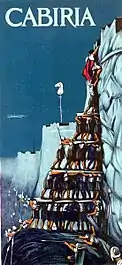

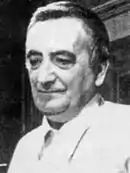

.jpg.webp)
